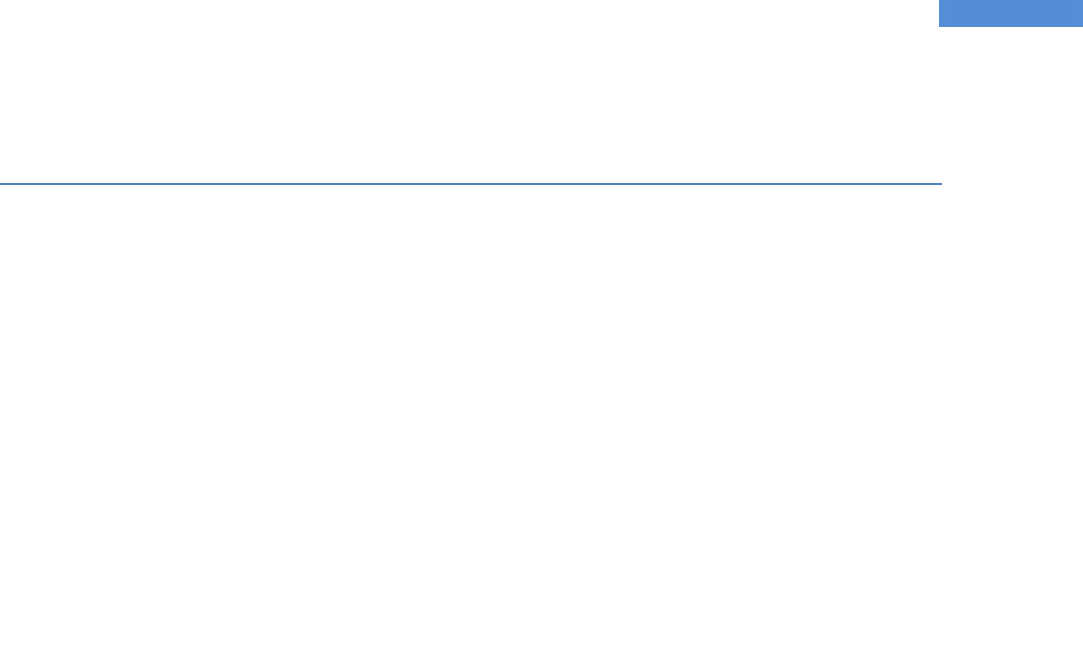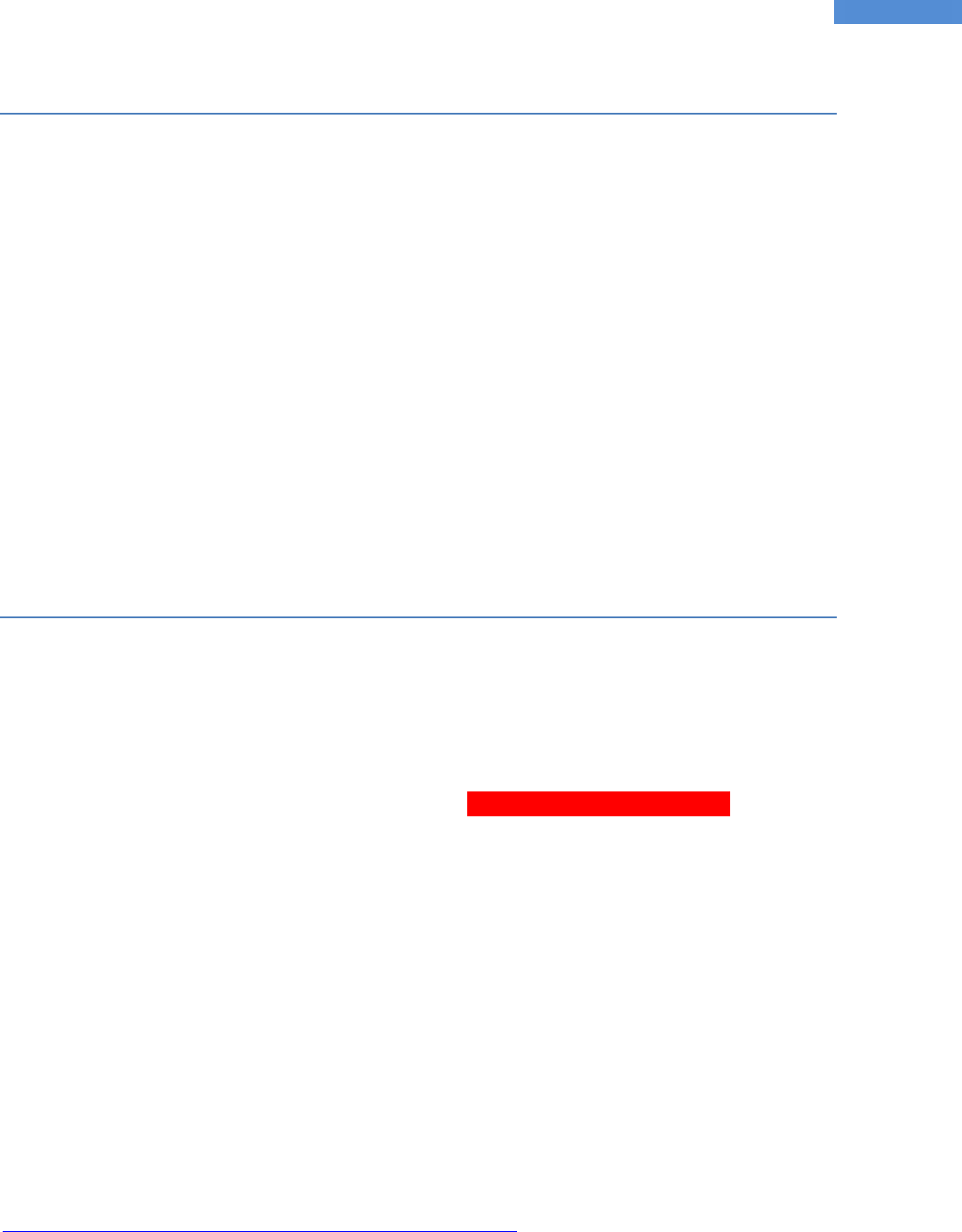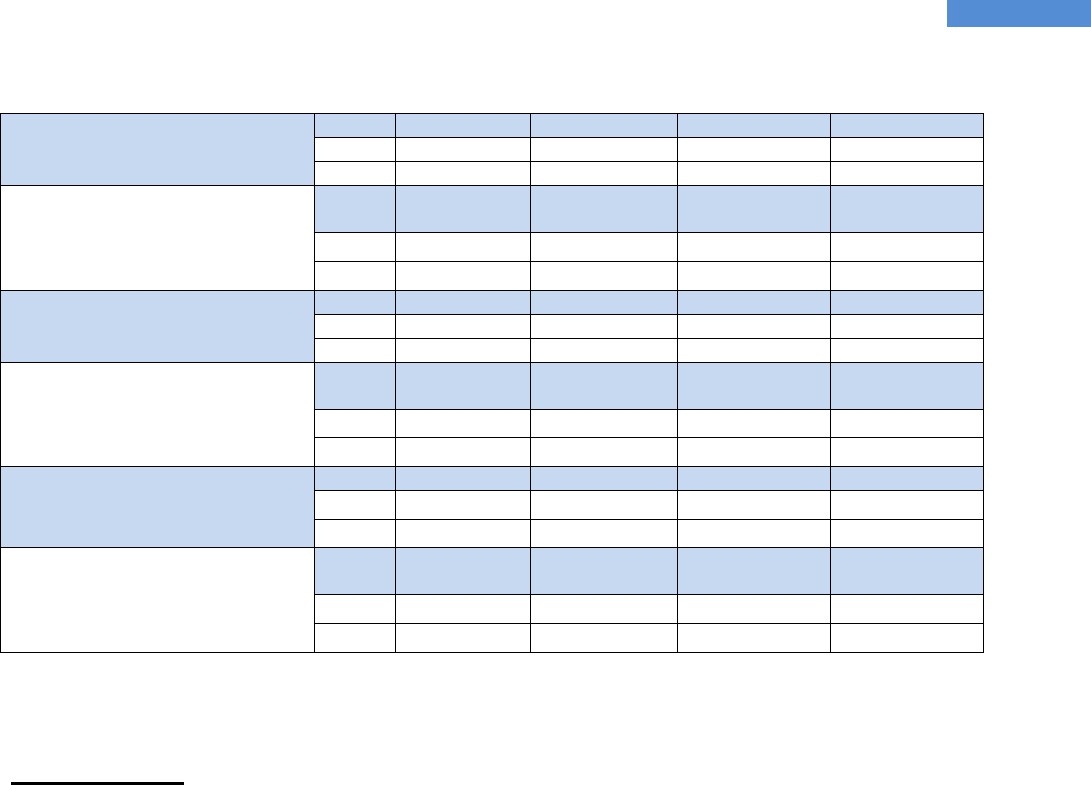
(CLERY ACT COMPLIANCE)
ANNUAL
REPORT
2023

2023 ANNUAL CAMPUS SECURITY and FIRE
SAFETY REPORT (Clery Act Compliance)
(Distributed October 1, 2023, for reporting years 2020 to 2022)
INDEX OF SUBJECTS: PAGES:
Letter from the Directors of Campus Security and Campus Safety...….……………………...2–3
Biographical Information of Cedarville University……………………………………………3
Personal Responsibility for Safety on Campus…………………………….……………......... 3–4
Important Phone Numbers………………………………………………………………….….4
Requesting Routine Assistance………………………………………………………………...5
Reporting Suspicious Persons or Criminal Activity and Other Emergencies………………....5-6
Emergency Phone Locations………………………………………………………………. …6-7
Campus Security Authorities – Responsible Offices and Persons (CSAs)..........................…. 7–9
Campus Security – Authority and Jurisdiction………………………………………………...9-10
Campus-wide – Emergency Notification (Alert) Procedure…………………………………. 10–12
Emergency Evacuations, Lockdown, or Sheltering in Place Situations……………………… 13–15
Crime Prevention and Information Programs………………………………………………… 16
Sexual Assault and Misconduct ……………………………………………………………… 16–32
Missing Student Procedure…………………………………………………………………….32–34
Reporting of Crime Statistics………………………………………………… .……………….... 35–39
Non-campus Properties and Public Property …………………………………………………39-41
Campus Crime Log and Crime Definitions...…………………………………………………41–43
Alcoholic Beverage – Illegal Drug Policy……………………………………………….……43
Possession – Use of Firearms or Other Weapons on Campus………………………………...44
Security in the Residence Halls……………………………………………………………….44–45
University Building – Maintenance Programs………………………………………………...46
Fire Safety – Prevention……………………………………………………………………….46–51
Further Information……………………………………………………………………………51
Cedarville University Campus Security Website

2
Annual Campus Security & Fire Safety Report (Clery Act Compliance)
Letter from the Director of Campus
Security Report Preparation
Dear students, faculty, and staff,
At Cedarville University, our goal is to provide a safe and secure campus. Campus Security and
Student/Residence Life work together to enhance the well-being of our University family.
However, the most effective means of achieving this goal is through a collaborative endeavor by
students, faculty, and staff. This document is our Annual Campus Security and Fire Safety
Report and is just one means of working together for a safe campus. It is provided to the campus
community, in compliance with the Jeanne Clery Disclosure of Campus Security Policy and
Campus Crime Statistics Act, generally referred to as the Clery Act in Section 485(f) of the
HEA. The Violence Against Women Reauthorization Act of 2013 (VAWA) (Public Law 113-4),
its amendments and reauthorizations, also includes amendments of the Clery Act. This report
from the University provides information relating to crime statistics and safety/security policies
and procedures. This information is distributed via official email to all current students and
employees, informing them of its contents and providing them with access to the full report. It is
also posted on the Campus Security website and is accessible to all interested persons, including
the general public.
In addition, the University informs all prospective students and employees of the availability of
this report and will provide it to them upon request. The report is prepared by the Director of
Campus Security and Director of Campus Safety and Risk Management and is compiled from
information obtained from Campus Security incident reports, information reported by Campus
Security Authorities (CSAs), Student Life records, and Title IX reports and from checking with
the local law enforcement agency having jurisdiction for any reported crimes on our campus.
This information is maintained by the University for at least seven years or as otherwise required
by records retention policies.
The University is committed to providing a safe environment for the campus community and
offers many programs and initiatives that enhance the campus safety, including:
▪ Security lighting around campus buildings and grounds
▪ Restricted access to residence halls on a 24-hour-a-day basis and all campus buildings
after normal business hours
▪ Security escort service after dark
▪ Surveillance cameras installed in certain strategic locations
▪ Security awareness and crime prevention materials and programs
▪ Emergency telephones located strategically throughout the campus
▪ Mass notification system for emergency communication to the campus
▪ A Campus Security Department with 24-hour-a-day patrol of the campus buildings
and grounds
▪ Direct communication and liaison with the Cedarville Police Department and the
Cedarville Township Volunteer Fire Department
The University is blessed in that it has not experienced a significant number of serious crimes;
however, criminal activity does occur both on campus and in the surrounding community.
Regardless of the size or geographic location of a university campus, it is imperative that

3
Annual Campus Security & Fire Safety Report (Clery Act Compliance)
students and employees stay alert to the possibilities of crime. By doing this, the University will
be better equipped to prevent future incidents. Having specific security-related policies and
procedures in place and adhering to good security practices is vitally important.
We encourage you to read the information in this document so that you will have an
accurate and realistic understanding of how you can take responsibility for your safety. We are
pleased to have you on campus for the academic year and pledge to work with you in making
your educational and work experience a positive and enjoyable one.
Sincerely,
Bruce Upchurch
Director of Campus Security
Douglas Chisholm
Director of Campus Safety & Risk Management
Biographical Information
Information:
Located in southwest Ohio, Cedarville University is an accredited Christ-centered, Baptist
institution with an enrollment of 5,082 undergraduate, graduate, and online students in more than
154 areas of study. Of the total number of students, 3,150 are housed on campus. Founded in
1887, Cedarville is recognized nationally for its authentic Christian community, rigorous
academic programs, strong graduation and retention rates, accredited professional and health
service offerings, and high engagement ranking. Approximately 627 faculty and staff members
serve our students who come from all around the world. The University is located on a 780-acre
campus at the north edge of the village of Cedarville, Ohio, a small-town community with a
population of approximately 3,848 residents.
Personal Responsibility for Safety on
Campus:
While the security policies and procedures at Cedarville University are designed for your safety
and welfare, you help to maintain your own safety both on and off campus by following all
security policies and by using common sense safety practices; these include but are not limited to
the following:
▪ Walking and jogging in groups at night in well-lit areas and not alone.
▪ Reporting suspicious persons to Campus Security immediately.
▪ Not leaving books, coats, purses, wallets, backpacks, laptop computers, or any item of
value unattended in public areas.

4
Annual Campus Security & Fire Safety Report (Clery Act Compliance)
▪ Keeping residence hall rooms locked when unoccupied and not propping open exterior
doors. For example, students are not to leave their door unlocked because their roommate
has lost his/her key.
▪ Reporting immediately to maintenance or security any doors, locks, or windows in need
of repair.
▪ Never lending your keys or your student ID card to anyone. Lending out, misuse, or
unauthorized use of your key is a violation of our Key Control Policy and may result in
confiscation of your key in certain cases.
▪ Faculty/staff keeping their offices locked when unoccupied or when leaving, even for a
brief moment.
▪ Keeping keys in a secure place, inaccessible to unauthorized persons.
▪ Locking vehicle doors at all times and securing valuables in the trunk.
▪ Not providing unidentified persons access to a residence hall or room. Do not allow door-
to-door salesmen to enter your residence hall or room. Campus regulations prohibit
soliciting, and the salesman may be casing your room.
▪ Understanding that Cedarville University is not liable for any property belonging to
faculty/staff, students or visitors that may be lost, stolen, or damaged in any way
wherever this may occur on the University property, including storage, cars, lobbies, and
laundry facilities. Students are encouraged to carry/obtain renters’ insurance or private
property insurance for protection.
The following document will provide you with an overview of helpful security facts. While some
of this material may seem more relevant to students, this information is of value to faculty and
staff members as well.
Important Phone Numbers
EMERGENCY CALLS
Emergency numbers operate 24-hours-a-day:
For assistance from a CAMPUS SECURITY OFFICER on campus:
• From a campus phone: 999
• From an off-campus phone: 937-239-6491
• For emergencies requiring police, ambulance, and/or fire department: 911
NON-EMERGENCY CALLS
For assistance from a CAMPUS SECURITY OFFICER on campus or to request routine
service:
Campus Security main office, 8 a.m. to 4:30 p.m. (located in SSC upper-level lobby near
Information Desk), Monday through Friday, dial 937-766-7992. At all other times, such as after
4:30 p.m. and on weekends and holidays, or if unable to reach the main office:
From a campus phone, dial 999
From an off-campus phone, dial 937-239-6491

5
Annual Campus Security & Fire Safety Report (Clery Act Compliance)
Requesting Routine Assistance
To request routine assistance from Campus Security, please contact our office at ext. 7992 or dial
937-766-7992 during normal business hours (8 a.m.–4:30 p.m.). At all other times, such as after
4:30 p.m., weekends, or holidays, or if you cannot reach the main office, dial 999 from a campus
phone (refer to the important phone number section of this document for additional details).
Routine requests include:
▪ Opening doors
▪ Assisting with issues with vehicles (such as jump starts and lockouts)
▪ Assisting with parking or traffic issues
▪ Requesting a personal escort or transport for safety reasons
▪ Reporting maintenance problems after normal business hours and on weekends and
holidays
▪ Requesting an officer to take an incident report for non-emergency situations, such as
minor vehicle accidents with no injuries, reporting lost or damaged property, etc.
Reporting Suspicious Persons or Criminal
Activity and other Emergencies
You may report suspicious persons, criminal activities, or other emergencies by dialing 999 on
any campus phone (from an off-campus phone, dial 937-239-6491). These numbers ring into the
Campus Security 24-hour-a-day emergency phone. You may also dial 911.
A campus security officer will respond to assist you, as well as local police, fire, or emergency
medical services, as the situation warrants. The responding officer(s) prepare and submit incident
reports for administrative review. Please remember to REPORT IT IMMEDIATELY, as it may
be imperative to make timely reports to the campus community warning others of the situation!
Campus Security personnel will not be able to respond to a crime or provide immediate
assistance to you if they don't know about it. This may include but is not limited to campus
thefts, assaults, sex offenses, disruptive behavior, vandalism, breaking and entering, suspicious
persons seen in and around campus residence halls and buildings, vehicle break-ins, fires,
alarms, gas odors, medical emergencies, and others.
You may report crimes or other incidents on a voluntary, confidential basis if necessary;
however, confidentiality cannot always be guaranteed, depending on the nature and
circumstances of the incident reported. In addition to reporting these matters to Campus Security,
students may also report them to the Associate Deans of Student Life, their Resident Director, or
the campus Title IX coordinator. Pastoral and professional counselors are encouraged to inform
clients of voluntary, confidential crime reporting procedures.
You may also file an incident report on-line with the Campus Security Office at:
https://www.cedarville.edu/offices/campus-security/security
If the incident is serious or the incident you are reporting has a known suspect, please
call Campus Security immediately or call 9-1-1.

6
Annual Campus Security & Fire Safety Report (Clery Act Compliance)
PLEASE NOTE: Reports filed on the “submit an incident report” web-link listed above are
monitored during normal business hours, Monday – Friday between 8:00 a.m. and 4:300 p.m.
Reports filed during other times, or during holidays, will be addressed on the next business day
after being filed.
Emergency Phone Locations
EMERGENCY TELEPHONES are available across the campus for fast reporting of incidents
and requesting assistance. Look for the YELLOW BOX (several are black) with a “blue-
colored" security light located over top of it to help you identify the location.
NORTH CAMPUS:
▪ Intramural fields on the north side of Route 72, across from Willetts Hall
▪ Walkway located adjacent to Willetts and Printy Halls on Cedar Lake Drive
▪ Upper entrance to the Stevens Student Center (SSC).
▪ SSC loading dock
▪ University Medical Center – main entrance
▪ Dixon Ministry Center loading dock
▪ Main entrance to the Center for Biblical and Theological
Studies (BTS), facing Cedar Lake
▪ BTS (south entrance)
▪ BTS (north entrance)
▪ BTS (east entrance, off from faculty/staff parking lot)
▪ Water Tower (lot #25) parking lot
▪ Tennis court area
▪ Athletics complex and track adjacent to the concession stand
▪ Townhouses – west end of townhouse #1, near parking lot
▪ West Hall – north end of building facing rear parking lot
SOUTH CAMPUS:
▪ Northwest entrance of the Engineering Project Lab (EPL),
which is also adjacent to the rear entrance of the Engineering
and Science Center (E&S)
▪ Sidewalk adjacent to Milner (MIL) and E&S
▪ Center for Teaching and Learning - front entrance
▪ Southeast entrance to Maddox Hall, facing the Apple Technology Resource Center
parking lot
▪ Faith Hall front entrance
▪ Carnegie Center for the Visual Arts basement - inside lower entrance
▪ Tyler Digital Communication Center (TYL) – south entrance off from parking lot
▪ TYL/MIL area – adjacent to sidewalk and roadway
▪ Alford Annex entrance
▪ Health Sciences Center (HSC) – west entrance facing the parking lot
▪ HSC – east entrance facing the lake
▪ HSC – south side outside EMS garage
▪ Northwest entrance of the Chemistry Laboratory Center

7
Annual Campus Security & Fire Safety Report (Clery Act Compliance)
WEST CAMPUS:
▪ Rear of grounds barn located at Operations Center – south side facing Automotive Center
and Cedarville Yellow Springs Road.
▪ Automotive garage – located at front entrance near garage entry doors
Campus Security Authorities (CSAs) –
Responsible Offices and Persons
“Campus security authority” is a Clery Act-specific term that encompasses four groups of
individuals and offices within an institution.
1. A campus police department or a campus security department of an institution.
2. Any individual(s) who have responsibility for campus security but who do not constitute
a campus police department or a campus security department.
3. Any individual or office specified in an institution’s statement of campus security policy
as an individual or office to which students and employees should report criminal
offenses.
4. An official of an institution who has significant responsibility for student and campus
activities, including, but not limited to, student housing, student discipline and campus
judicial proceedings. An official is defined as any person who has the authority and the
duty to act or respond to particular issues on behalf of the institution.
The function of a CSA is to report to the official or office designated by the University to collect
crime report information, those allegations of Clery Act crimes (see pp. 41-43 for definitions)
that he or she may have become aware of or was involved in investigating in any way during the
year while serving in the capacity of a CSA. At Cedarville University, this office is the Campus
Security Department and, specifically, the Director of Campus Security. CSAs timely file their
reports on crimes with the Campus Security Department for inclusion in the Daily Crime Log,
this Security Report, and other required reports.
Additional Campus Security Authorities (CSAs):
In addition, other offices or individuals on campus are considered to be Campus Security
Authorities (CSA). These would include individuals who have significant responsibility for
student and campus activities.
Included in this category would be:
▪ Associate deans of residence life, resident directors and resident assistants
▪ Directors of campus experience and activities
▪ Directors of athletics, athletic team coaches
▪ Faculty advisors to student groups
▪ Student life counselors (except for exempted officials such as pastoral and professional
counselors)
▪ Medical director of University Medical Services
▪ Physicians/nurse practitioners of University Medical Services

8
Annual Campus Security & Fire Safety Report (Clery Act Compliance)
▪ Study abroad coordinators
▪ Title IX Coordinator or those with associated responsibilities
A faculty member who does not have any responsibility for student and campus activity beyond
the classroom would not meet the criteria of a CSA.
For purposes of the Clery Act, CSAs are not responsible for investigating or reporting incidents
that they overhear students talking about in a hallway conversation; that a classmate or student
mentions during an in-class discussion; that a victim mentions during a speech, workshop, or any
other form of group presentation; or that the CSA otherwise learns about in an indirect manner.
Regardless of whether someone is a CSA or not, we encourage all persons to promptly report
any crimes or offenses that they are aware of occurring on or near campus to Campus Security
(see requirements under employee responsibilities to report incidents under Title IX). By doing
so, the entire campus community will participate in helping to maintain a safe and secure
environment.
CSAs are provided information to ensure that they understand their role either by email and/or
by participating in training meetings and other communications.
Mandatory Reporting Obligations Under Title IX:
All employees of the University are required to report Prohibited Conduct (as defined in the Title
IX Policy) to the Title IX Coordinator as soon as possible after the information becomes known.
The Title IX Coordinator may be contacted as follows:
Shannon Berkheiser
Dixon Ministry Center 180
251 North Main Street
Cedarville, Ohio 45314
Telephone: 937-766-7777
Email: [email protected]
Those mandatory reports are required to include the name of the employee filing the report, as
well as all information known to the employee. This requirement does not apply to a report that
the employee has experienced the Prohibited Conduct himself or herself.
All employees of the University are likewise required to report felonies (including sexual
assault) to law enforcement. Such reports may be facilitated by the Title IX Coordinator or
Campus Security, but it is the obligation of the employee to ensure that the report is made.
Employees that do not make a mandatory report under this section may be subject to discipline,
up to and including termination of employment.
Upon receiving a mandatory report, the Title IX Coordinator will reach out to the potential
complainant to ask if they would like to meet to discuss supportive measures and other options.
Potential complainants will not be required to meet with the Title IX Coordinator in response to
the receipt of a mandatory report.

9
Annual Campus Security & Fire Safety Report (Clery Act Compliance)
This information can be found under the University, Title IX Sex Discrimination Policy – under
Section VI, item G.
https://www.cedarville.edu/offices/title-ix/policy/reporting-prohibited-conduct-and-accessing-
supportive-measures
Campus Security - Authority and
Jurisdiction
The Director of Campus Security maintains overall responsibility for the operational and service-
related security functions for the university. Campus Security is organized as follows:
▪ Administrative Director of Campus Security
▪ Administrative Director of Campus Safety & Risk Management
▪ One field captain – responsibilities include shift operations, security operations, parking
management, and officer training.
▪ Field sergeant or designee – responsibilities include evening shift operations supervision
and officer training
▪ Department secretary and office staff
▪ Access control division with one supervisor (rank of lieutenant) and three technicians
who service and manage doors/locks, keys, door hardware and surveillance cameras
▪ Six full-time security patrol officers
▪ One part-time security patrol officer
▪ Student security patrol officers (cadets) ranging from six to eight persons
The officers working with the department are primarily selected based on prior experience and
training in private security, police, fire, military, or emergency medical service. Most of the
officers have degrees in criminal justice/police science, have specialized security training, or, in
the case of students, are involved in working toward completing their degree. Training includes,
but is not limited to, legal updates and issues, crime prevention strategies, safety, fire and
evacuation response, emergency preparedness, report writing, CPR/basic first aid, and self-
defense and crisis intervention training.
Most full-time and part-time officers are certified in the use of tasers, pepper spray, and asp
batons and are authorized to carry these nonlethal weapons while on duty. The director and most
members of the supervisory and patrol staff are also trained and OPOTC (Ohio Peace Officer
Training Commission) state certified to carry firearms while in the course of their duties as
private security personnel. In addition, they undergo tactical training on a regular basis that
involves responding to crisis situations or acts of violence that may occur on campus.
Campus Security Department personnel function as professional security officers. This means
that they do not have police authority or powers of arrest in the state of Ohio. Since the majority
of the University is located within the village of Cedarville and Greene County, the Cedarville
Police Department serves as the primary jurisdictional authority responsible for investigating
crimes on campus. Depending on the case, the Greene County Sheriff's Department may assume
ultimate control or assist with any investigation within the village. The University also has a
contract agreement with the village police to assist with:

10
Annual Campus Security & Fire Safety Report (Clery Act Compliance)
▪ Traffic control on the public roadways located adjacent to the University
▪ Providing law enforcement coverage for Campus Security when special events are held at
the University that may demand a heightened level of safety and security
In general, serious criminal offenses, such as those included in the Campus Security Report
Crime Statistics section, are reported to the local police for investigation and oversight. Cases
involving minor offenses, such as petty theft, criminal mischief, trespassing, disorderly conduct,
vandalism, etc., are reported to the local police depending on the nature and seriousness of the
offense and joint investigative efforts are deployed to manage these matters. Regardless of the
nature of the offense, individual perpetrators may be arrested and charged in accordance with
state and local laws. Infractions involving University rules and regulations are promptly reported
to Student Life for disciplinary action. The Cedarville Police and Campus Security have a mutual
agreement of understanding on reporting and investigating criminal matters.
Campus Security personnel work closely with the local police and have direct radio
communication with them on a 24-hour-a-day basis. Cedarville University is part of the Greene
County 911 Emergency Notification System. Situations occurring in the village, township, or
county that may impact the University are brought to the attention of Campus Security by the
local police or county sheriff’s department. Some of these situations may involve students
residing in off campus rental properties within the village or township that are not owned or
operated by the University. The University does not own or operate housing used for student
fraternity or sorority organizations.
Campus-wide - Emergency Notification
(Alert) Procedure
If it becomes necessary to notify the entire campus of a significant emergency or dangerous
situation involving an immediate threat to the health or safety of students, faculty, and staff, the
University has developed a campus alert procedure. Alerts may include, but are not limited to,
notifications for campus closings or delays due to inclement weather, tornado warnings, campus-
wide power or utility failure, the need for immediate building evacuation, fire/explosion, and
potential or actual acts of campus violence.
Campus-wide notifications will come from our Mass Emergency Notification System. All
members of the campus community are automatically signed up for this free service with the
number provided during the application process. This system calls office, home, and cell phone
numbers and sends texts and emails.
Two different kinds of alerts may be issued to the campus community:
Timely Warnings – will primarily be issued to the campus for Clery Act crimes only. These
events are narrower in scope and may affect a smaller segment of the campus, such as burglary
with theft occurring in one particular building on campus. A timely warning may also focus on
crimes that have occurred in the past but now constitute an ongoing threat, anywhere on
university-owned property or in close proximity. Typically, these notices are issued as soon as
pertinent information is available in a manner that is timely and that will aid in preventing

11
Annual Campus Security & Fire Safety Report (Clery Act Compliance)
similar occurrences, unless issuing a notification will compromise efforts to contain the
emergency as determined by law enforcement, emergency management, and University officials.
In the case of a “timely warning,” the Campus Security or Campus Safety Director may issue the
warning or delegate this responsibility to the Student Life deans, as it may involve resident
facilities on campus. In less threatening situations, the campus email system may be used to
inform a smaller group to take precautions, such as a reminder to secure their room doors in a
situation where money or other items are being taken from student rooms located in a specific
residence hall facility.
Emergency Notifications – will primarily be issued for emergencies that are much wider in
scope, may be currently occurring, and involve situations that pose an imminent threat to the
campus community. This could include tornado warnings or a violent threat such as a report of
an active shooter. These notifications are issued upon confirmation of a dangerous actual or
threatening situation by the local police, Campus Security, Student Life, or other administrative
departments at the University. These notifications would be sent out to the entire student body
and faculty/staff by utilizing our Mass Emergency Notification System. The primary persons
responsible for this task are the Director of Campus Security or the Director of Campus Safety
and Risk Management. The Director of Public Relations may be delegated to perform this task if
so directed.
The Cedarville Police Department also maintains immediate communication with the campus in
the event that it becomes aware of a situation in the local community that may warrant a
notification to the campus. The following is an overview of how notifications are made to the
campus.
An immediate alert (generally 1–15 minutes after the emergency situation is reported, if
possible). This may include tactical instructions to building occupants.
▪ Campus-wide Mass Emergency Notification System will be initiated that alerts students,
faculty, and staff of the emergency situation via text message, voice mail, email, or alert
messages that will appear throughout public areas on campus where large screen TVs are
located.
▪ Patrol vehicles may be used to drive through the campus, sounding sirens and making
appropriate PA announcements. In some law enforcement situations, this method may not
be desirable.
▪ Direct contacts to the major facilities on campus may be conducted by Campus Security,
the police, assigned Physical Plant personnel, or phone contacts made by the campus
telephone operators.
▪ The campus computer network may also be used to send out an email to the entire
campus community separate from the mass notification system.
An Emergency Alert (generally 15-60 minutes after the emergency situation is reported if
possible). This includes further emergency announcements or instructions. The same methods as
outlined in the immediate alert may be utilized.
An Advisory Alert (generally 1-24 hours after the emergency situation is reported if
possible). This includes updates, warnings or potential threats, and announcements.
▪ The Campus Mass Emergency Notification system can be utilized, or it may be
appropriate to send an email using the campus computer network.

12
Annual Campus Security & Fire Safety Report (Clery Act Compliance)
In the event of situations where an immediate alert may not be necessary, notifications are generally
initiated by using the campus computer email system or may appear in the Campus Today daily
email update to faculty and staff. This may include, but is not limited to, situations regarding theft
from vehicles in campus parking lots, reports of vandalism, or observed suspicious activity. These
are generally situations that are less threatening and not considered Clery reportable incidents, but it
may be prudent to alert members of the campus community to take precautions to prevent further
incidents.
Information on Emergency Drills and Exercises:
At Cedarville University, the emergency alert system is tested for effectiveness at least once
annually during the academic school year. Additional tests may be performed as determined by
the Campus Security director and/or University administration. Tests are typically announced in
advance to members of the campus community, and the campus emergency response and
evacuation procedures are included within the text message and/or email.
In addition to the test, the University schedules drills/training exercises that are designed to
evaluate and review our ability to respond to certain emergency situations. For reporting years
2020 through 2022, drills/exercises were held that focused on dealing with active shooter and
threat assessment situations that were staged in several of our campus academic buildings using
actors and/or law enforcement expert(s). All test/drills are recorded in a report with the
description of the exercise, the date, time, details, and evaluation of the drill and whether it was
announced or unannounced.
In the summer of 2018 and fall semester of 2019, the University also held tabletop drills that
tested our Emergency Communications Plan. These focused on active shooter and bomb threat
scenarios. Participants included members of our crisis communications team, administrators, and
campus security officials. In the fall of both years, evacuation drills were conducted at several
residence halls, using the fire alarm system as well as our emergency alert notification system.
Campus Security and Residence Life staff participated with this event. This helped evaluate the
effectiveness of our Fire Procedure Plans for campus residence halls.
In addition, in preparation of the new school year in August 2020 and in view of the COVID-19
pandemic, a tabletop drill was conducted for all of the Administrative Cabinet members
including the President and University Medical Director. Safety procedures and campus
protocols were reviewed to help the University further develop our response strategies for
medical evaluation, testing, isolation, and quarantine procedures.
In the fall of 2017, a special presentation was provided for all faculty/staff in the Run, Hide, and
Fight active shooter response procedures (see p. 14, item 4). In the fall of 2019, a similar
presentation was presented to all members of the student community in one of the scheduled
chapel services. The presentation was conducted by a specialist in the field of Emergency
Preparedness.
* Note: Faculty/staff and students can add additional phone numbers for the emergency
notification (alert) system by accessing the myCU search portal. Once there, search under
“signup for Emergency Notifications” and complete the online application and submit.

13
Annual Campus Security & Fire Safety Report (Clery Act Compliance)
Emergency Evacuations, Lockdown, or
Sheltering in Place Procedures
Depending on the specific nature of an emergency situation, it may become necessary to
evacuate a building either completely, partially, or to lockdown or shelter in place. Faculty, staff,
and students should be aware of the different types of incidents that could result in utilizing these
methods to maintain the safety and security of the campus community. In order to alert and
maintain communications with all members of the campus, the mass emergency notification
system will be used as appropriate. Campus Security will take the leading role in facilitating
these procedures.
DEFINITIONS:
1. EVACUATION: Temporary but rapid removal of people from a building or portion of a
building that is threatened by an emergency situation, used as a rescue or precautionary
measure.
2. LOCKDOWN: A lockdown occurs when occupants of the facility are directed to remain
confined to a room/area with specific procedures to follow regarding locking of doors,
closing of windows/shades, seeking cover, etc. This procedure is implemented when a
criminal element is believed to be on the premises and officials expect that these measures
will minimize risk exposure of the occupants to the criminal element. Lockdowns necessitate
a law enforcement response and immediate intervention.
3. SHELTER IN PLACE: Sheltering in place is similar to a lockdown in that the occupants
are to remain on the premises but may need to be moved to a different part of the facility due
to an environmental event taking place outside of the facility, for example the release of a
chemical cloud in the area or a tornado warning situation. To evacuate the occupants may put
them at greater risk then sheltering them within the facility. However, it may be prudent to
move all of the occupants to another part of the facility to further minimize the risk of
exposure.
INCIDENT TYPES:
1. Fire or Explosion – detailed procedures have been outlined in our Fire Response Plans that
can be found on the Campus Security website under Emergency Procedures. These have
been summarized for you below.
If you are in a building where you observe an active fire, explosion, or smoke throughout the
corridors, in a classroom, or other areas of the building, do the following:
a) Activate a fire alarm pull station. Activating a pull station will sound the “audible horn
and strobe lights” throughout the building.
b) Notify 911 immediately and contact Campus Security (at least one person needs to
ensure that this has been accomplished). Give the exact location and nature of the
situation. Most buildings have fire systems that will automatically notify the fire

14
Annual Campus Security & Fire Safety Report (Clery Act Compliance)
department but making a call will provide additional details of the situation to the 911
dispatcher.
c) Confine the fire by closing all the doors in the area and rescue anyone in immediate
danger, only if you can do so safely.
d) Evacuate the building via the nearest exit, in a controlled yet rapid manner. All persons
are to use the stairs, not elevators, during a fire alert situation. Persons exiting the
building should walk at least 50–100 feet from the building, keeping the main building
access clear for incoming emergency vehicles. This applies to ALL OCCUPANTS,
including faculty, staff, students, visitors, guests, contractors and vendors.
e) Remain Outside the building until the fire department and Campus Security has arrived
to assess the situation, which includes a search of the building for any remaining
occupants. Approval to return to the building is subject to the authorization of the fire
chief.
2. Gas Leaks/Strong Odors of Gas – if this condition occurs in any building on campus,
the fire alarm system is not to be used as it could become an ignition source that could
potentially contribute to an explosion.
The following steps should be taken:
a) Warn others in your area to leave the building immediately. While leaving in a
controlled and orderly manner, prop the exterior doors open using a door wedge, if
available, or by using nearby furniture such as a chair.
b) Notify 911 immediately and contact Campus Security (at least one person needs to
ensure that this has been accomplished). Give the exact location and nature of the
situation.
c) Follow steps D and E under the Fire Response procedures – evacuate and remain
outside until approval to return to the building is given by the fire chief.
3. Bomb Threat Situations – in the event that a threat is received, or a suspicious package
or device is observed, University administration, Campus Security, and law enforcement
will determine the course of action to be taken. Depending on the circumstances, you
may be instructed to evacuate the building.
4. Active Threat (Shooter) Situations – as indicated in the University Active Shooter
Response Plan that is posted on the Campus Security website under Emergency
Procedures, the University has adopted the Department of Homeland Security’s RUN,
HIDE, or FIGHT response method.
a) Run – evacuate the building or section of building where you are located as rapidly
as possible when you first learn of the threat, as long as it is safe for you to do so
without exposing yourself to further harm. You can exit through the exterior doors or
consider using a window, if necessary, by breaking your way out. Strike window
glass at the top or bottom corners. Leave your belongings behind. Keep your hands
visible if you see law enforcement or rescue personnel in the area. Move as far away
from the threat as possible.

15
Annual Campus Security & Fire Safety Report (Clery Act Compliance)
b) Hide – if you are unable to evacuate or you are located in another building away from
the immediate threat, then you should go into lockdown. This is accomplished by
going to a securable room and locking yourself inside, by barricading the doors with
desks, tables, chairs, file cabinets, or any other object that can prevent or slow down
entry by a perpetrator. Turn off the lights and turn down your cell phones. Pull shades
on the windows if applicable and remain quiet. Do not huddle together in one
location.
c) Fight – if all else fails and as a last resort, attempt to stop the perpetrator by any
means necessary. You can throw items at them to cause a distraction. Strike the
person with chairs, discharge a fire extinguisher at them, or wrestle them to the floor.
Act with physical aggression and commit yourself to your actions.
5. Power or Utility Failure – in the event that one of the campus academic or business
buildings, or a portion of a building, experiences a power outage in excess of 45 minutes
to one hour (this is the general time frame that portable emergency lights will maintain
power) and the building does not have an emergency generator that can sustain continued
occupancy, those facilities may be evacuated, partially determined by whether the failure
occurs during day-light or night hours.
Buildings with full generator capability that can maintain occupancy during power
outages:
a) Fitness Recreation and Callan Athletic Center
b) Dixon Ministry Center
c) Stevens Student Center
d) Health Sciences Center
e) Davis House (Campus Security building)
These evacuations procedures do not apply to residence halls because residence halls are
considered the on-campus living quarters for the student body.
6. Tornado Emergencies – during this type of emergency, occupants of all buildings
should not evacuate but go to the lowest level of the building that they are located in at
the time of the emergency and shelter in place in the innermost sections such as
restrooms, corridors, classrooms, and offices that are not near exterior walls and
windows. Avoid gyms or large auditorium facilities. Occupants of some buildings may be
directed to adjacent buildings.
More detailed instructions for each building on campus are contained on the Campus
Security website under Emergency Procedures.
7. Complete Campus Evacuation – this would typically be a planned and announced event
where the campus was experiencing a sustained loss of power, utilities, or severe damage
from a major environmental event such as tornado, earthquake, or another catastrophic
event. This response level would be considered rare.

16
Annual Campus Security & Fire Safety Report (Clery Act Compliance)
Crime Prevention and Information
Programs
Cedarville University Campus Security strives to conduct itself in a proactive manner. In
achieving this end, the following is a list of methods used on our campus to provide crime
prevention and information to our students and employees.
▪ Distribution of pertinent literature or PowerPoint presentations at the start of the
academic school year during the Getting Started Weekend parking registration process.
▪ Q&A opportunities via Campus Security promotion events, held during the academic
school year.
▪ Brochures available at the Campus Security office on a wide range of campus safety
issues.
▪ Periodic computer-generated emails relative to crime prevention and security information
sent to all members of the campus community.
▪ Timely reports of any threats to students or employees in a manner that will aid in
preventing similar occurrences. These reports are issued through the computer-generated
email system or through written or verbal information briefs provided by resident
directors, deans, or campus security personnel.
▪ Daily campus security patrols of the entire campus conducted 24/7 by foot, bicycle, or in
marked and unmarked vehicles.
▪ Security escort services offered after dark for individuals requesting escort to their
residence hall or to and from on-campus buildings and parking lots.
▪ Emergency telephones strategically installed throughout the campus property for quick
reporting of incidents and for making requests for security related assistance.
▪ Surveillance cameras located in strategic areas of the campus for investigative purposes.
Sexual Assault, Misconduct and
Harassment
The Violence against Women Reauthorization Act (VAWA) was signed into law on March 7,
2013. As a result, new obligations were imposed on colleges and universities under the Campus
Sexual Violence Elimination Act (SAVE Act) provision, Section 304. These obligations both
refined and clarified the existing legal requirements and have added changes that are
incorporated into our Annual Campus Security (Clery) Report. This policy addresses these
requirements and outlines the ways that we respond to them.
General Policy Statement
All forms of violence and sexual misconduct directed toward another person will be considered
unacceptable at Cedarville University. Of special note are acts that are sexually-oriented and
include:
1) Sexual assault – rape, fondling, incest, and statutory rape (Clery & Title IX Offenses)
2) Dating violence – VAWA (Clery & Title IX Offenses)
3) Domestic violence – VAWA (Clery & Title IX Offenses)
4) Stalking – VAWA (Clery & Title IX Offenses Offenses)

17
Annual Campus Security & Fire Safety Report (Clery Act Compliance)
5) Sexual Harassment (Title IX Offense) – Quid Pro Quo and Unwelcome Conduct
Offenses involving items two (2) through four (4) were added to the Clery reportable crimes as a
result of VAWA regulations and are included in our campus security report in addition to crimes
listed in item one (1). Definitions have been provided to help you understand the nature of each
of these offenses. It is important to note that all of these offenses are considered a violation of the
law as well as University policy and should be reported to the appropriate University officials as
well as law enforcement.
In addition, on August 14, 2020, the Department of Education issued new requirements
addressing changes to the Title IX regulations regarding sexual harassment. In order to comply
with these regulations, the University has revised its policy, which can be found at:
cedarville.edu/titleIXpolicy
The prohibitions in this policy apply to all University community members, including students,
faculty, administrators, staff, volunteers, vendors, independent contractors, visitors, alumni, and
any individuals regularly or temporarily employed, studying, living, visiting, conducting
business, or having any official capacity with the University or on university property. In
particular, off-campus conduct is subject to this policy if the conduct occurred in the context of
an education program or activity of the University or had continuing adverse effects on campus
or in an off-campus education program or activity.
Sexual harassment is antithetical to biblical and academic values and to a work environment free
from the fact or appearance of coercion. Sexual harassment is a form of sex discrimination, a
violation of university policies, and may result in serious disciplinary action.
There are six types of prohibited conduct that qualify as “sexual harassment” as defined by the
federal Title IX regulations in 34 C.F.R. 106.30, each of which is defined more specifically in
the University’s Title IX policy. They are: (1) quid pro quo, (2) unwelcome conduct, and the
additional four (4) Clery Act offenses previously mentioned.
Clery Act and Title IX Definitions
For purposes of this report, the definition of sexual assault meets the FBI’s Uniform Crime
Reporting system and is outlined below, also included are the definitions for VAWA and Title
IX offenses.
Sexual Assault – any sexual act directed against another person, without the consent of the
victim, including instances where the victim is incapable of giving consent.
i. Rape: The penetration, no matter how slight, of the vagina or anus with any body part or object,
or oral penetration by a sex organ of another person, without the consent of the victim.
ii. Fondling: The touching of the private parts of another person for the purpose of sexual
gratification, without the consent of the victim, including instances where the victim is incapable
of giving consent because of his/her age or because of his/her temporary or permanent mental
incapacity.
iii. Incest: Sexual intercourse between persons who are related to each other within the degrees
wherein marriage is prohibited by law.

18
Annual Campus Security & Fire Safety Report (Clery Act Compliance)
iv. Statutory Rape: Sexual intercourse with a person who is under the statutory age of consent.
Dating Violence – violence committed by a person who is or has been in a social relationship of
a romantic or intimate nature with the victim.
The existence of such a relationship shall be based on evidence such as the reporting party’s
statement and with consideration of the length of the relationship, the type of relationship, and
the frequency of interaction between the persons involved in the relationship.
For the purposes of this definition –
a. Dating Violence includes, but is not limited to, sexual or physical abuse or the threat of such
abuse.
b. Dating Violence does not include acts covered under the definition of domestic violence.
Any incident meeting this definition is considered a crime for the purposes of Clery Act reporting.
In the state of Ohio, there is no specific dating violence criminal code. Offenders will be charged
using the appropriate criminal code based on the offense.
Domestic Violence – a felony or misdemeanor crime of violence committed –
i. By a current or former spouse or intimate partner of the victim.
ii. By a person with whom the victim shares a child in common.
iii. By a person who is cohabitating with, or has cohabitated with, the victim as a spouse or intimate
partner.
iv. By a person similarly situated to a spouse of the victim under the domestic or family violence
laws of the jurisdiction.
v. By any other person against an adult or youth victim who is protected from that person’s acts
under the domestic or family violence laws of the jurisdiction in which the crime of violence
occurred.
For the purposes of complying with the requirements of the Violence against Women Act (VAWA),
any incident meeting this definition is considered a crime for the purposes of Clery Act reporting.
Stalking – engaging in a course of conduct directed at a specific person that would cause a reasonable
person to
i. Fear for the person’s safety or safety of others; or
ii. Suffer substantial emotional distress.
iii. For the purposes of this definition –
a. Course of conduct means two or more acts, including, but not limited to, acts which the
stalker directly, indirectly, or through third parties, by any action, method, device, or
means follows, monitors, observes, surveils, threatens, or communicates to or about, a
person, or interferes with a person’s property.
b. Reasonable person means a reasonable person under similar circumstances and with
similar identities to the victim.
c. Substantial emotional distress means significant mental suffering or anguish that may, but
does not necessarily, require medical or other professional treatment or counseling.
Sexual Harassment – Title IX Sexual Harassment includes any of the following:

19
Annual Campus Security & Fire Safety Report (Clery Act Compliance)
i. Quid Pro Quo - Conduct on the basis of sex where a university employee conditions the
provision of an aid, benefit, or service of the University on an individual’s participation
in unwelcome sexual conduct.
ii. Unwelcome Conduct - Unwelcome conduct on the basis of sex determined by a
reasonable person to be so severe, pervasive, and objectively offensive that it effectively
denies a person equal access to the recipient’s education program or activity.
Ohio Revised Code (ORC) Definitions:
Ohio provides definitions of sexual offenses that differ somewhat from those of the FBI. When a
sex offense occurs and the perpetrator is referred to criminal court, they are normally charged
under the provisions of the ORC. Those codes are listed and the described below in italics.
2907.02 Rape.
(A)(1) No person shall engage in sexual conduct with another who is not the spouse of the
offender or who is the spouse of the offender but is living separate and apart from the offender,
when any of the following applies:
(a) For the purpose of preventing resistance, the offender substantially impairs the other
person’s judgement or control by administering any drug, intoxicant, or controlled substance to
the other person surreptitiously or by force, threat of force, or deception.
(b) The other person is less than thirteen years of age, whether or not the offender knows the age
of the other person.
(c) The other person’s ability to resist or consent is substantially impaired because of a mental
or physical condition or because of advanced age, and the offender knows or has reasonable
cause to believe that the other person’s ability to resist or consent is substantially impaired
because of a mental or physical condition or because of advanced age.
(2) No person shall engage in sexual conduct with another when the offender purposely compels
the other person to submit by force or threat of force.
2907.03 Sexual battery.
(A) No person shall engage in sexual conduct with another, not the spouse of the offender, when
any of the following apply:
(1) The offender knowingly coerces the other person to submit by any means that would prevent
resistance by a person of ordinary resolution.
(2) The offender knows that the other person’s ability to appraise the nature of or control the
other person’s own conduct is substantially impaired.
(3) The offender knows that the other person submits because the other person is unaware that
the act is being committed.

20
Annual Campus Security & Fire Safety Report (Clery Act Compliance)
(4) The offender knows that the other person submits because the other person mistakenly
identifies the offender as the other person’s spouse.
(5) The offender is the other person's natural or adoptive parent, or a stepparent, or guardian,
custodian, or person in loco parentis of the other person.
(6) The other person is in custody of law or a patient in a hospital or other institution, and the
offender has supervisory or disciplinary authority over the other person.
(7) The offender is a teacher, administrator, coach, or other person in authority employed by or
serving in a school for which the state board of education prescribes minimum standards pursuant to
division (D) of section 3301.07 of the Revised Code, the other person is enrolled in or attends that
school, and the offender is not enrolled in and does not attend that school.
(8) The other person is a minor, the offender is a teacher, administrator, coach, or other person in
authority employed by or serving in an institution of higher education, and the other person is
enrolled in or attends that institution.
(9) The other person is a minor, and the offender is the other person's athletic or other type of coach,
is the other person's instructor, is the leader of a scouting troop of which the other person is a
member, or is a person with temporary or occasional disciplinary control over the other person.
(10) The offender is a mental health professional, the other person is a mental health client or patient
of the offender, and the offender induces the other person to submit by falsely representing to the
other person that the sexual conduct is necessary for mental health treatment purposes.
(11) The other person is confined in a detention facility, and the offender is an employee of that
detention facility.
(12) The other person is a minor, the offender is a cleric, and the other person is a member of, or
attends, the church or congregation served by the cleric.
(13) The other person is a minor, the offender is a peace officer, and the offender is more than two
years older than the other person.
2907.04 Unlawful sexual conduct with minor.
(A) No person who is eighteen years of age or older shall engage in sexual conduct with another,
who is not the spouse of the offender, when the offender knows the other person is thirteen years of
age or older but less than sixteen years of age, or the offender is reckless in that regard.
2907.05 Gross sexual imposition.
(A) No person shall have sexual contact with another, not the spouse of the offender; cause another,
not the spouse of the offender, to have sexual contact with the offender; or cause two or more other
persons to have sexual contact when any of the following applies:
(1) The offender purposely compels the other person, or one of the other persons, to submit by force
or threat of force.
(2) For the purpose of preventing resistance, the offender substantially impairs the judgment or
control of the other person or of one of the other persons by administering any drug, intoxicant, or
controlled substance to the other person surreptitiously or by force, threat of force, or deception.

21
Annual Campus Security & Fire Safety Report (Clery Act Compliance)
(3) The offender knows that the judgment or control of the other person or of one of the other persons
is substantially impaired as a result of the influence of any drug or intoxicant administered to the
other person with the other person's consent for the purpose of any kind of medical or dental
examination, treatment, or surgery.
(4) The other person, or one of the other persons, is less than thirteen years of age, whether or not
the offender knows the age of that person.
(5) The ability of the other person to resist or consent or the ability of one of the other persons to
resist or consent is substantially impaired because of a mental or physical condition or because of
advanced age, and the offender knows or has reasonable cause to believe that the ability to resist or
consent of the other person or of one of the other persons is substantially impaired because of a
mental or physical condition or because of advanced age.
(B) No person shall knowingly touch the genitalia of another, when the touching is not through
clothing, the other person is less than twelve years of age, whether or not the offender knows the age
of that person, and the touching is done with an intent to abuse, humiliate, harass, degrade, or
arouse or gratify the sexual desire of any person.
2907.06 Sexual imposition.
(A) No person shall have sexual contact with another, not the spouse of the offender; cause another,
not the spouse of the offender, to have sexual contact with the offender; or cause two or more other
persons to have sexual contact when any of the following applies:
(1) The offender knows that the sexual contact is offensive to the other person, or one of the other
persons, or is reckless in that regard.
(2) The offender knows that the other person’s, or one of the other person's, ability to appraise the
nature of or control the offender's or touching person's conduct is substantially impaired.
(3) The offender knows that the other person, or one of the other persons, submits because of being
unaware of the sexual contact.
(4) The other person, or one of the other persons, is thirteen years of age or older but less than
sixteen years of age, whether or not the offender knows the age of such person, and the offender is at
least eighteen years of age and four or more years older than such other person.
(5) The offender is a mental health professional, the other person or one of the other persons is a
mental health client or patient of the offender, and the offender induces the other person who is the
client or patient to submit by falsely representing to the other person who is the client or patient that
the sexual contact is necessary for mental health treatment purposes.
2919.25 Domestic violence.
(A) No person shall knowingly cause or attempt to cause physical harm to a family or household
member.
(B) No person shall recklessly cause serious physical harm to a family or household member.

22
Annual Campus Security & Fire Safety Report (Clery Act Compliance)
(C) No person, by threat of force, shall knowingly cause a family or household member to believe
that the offender will cause imminent physical harm to the family or household member.
2903.211 Menacing by stalking.
(A)(1) No person by engaging in a pattern of conduct shall knowingly cause another person to
believe that the offender will cause physical harm to the other person or cause mental distress to the
other person. In addition to any other basis for the other person's belief that the offender will cause
physical harm to the other person or the other person's mental distress, the other person's belief or
mental distress may be based on words or conduct of the offender that are directed at or identify a
corporation, association, or other organization that employs the other person or to which the other
person belongs.
(2) No person, through the use of any electronic method of remotely transferring information,
including, but not limited to, any computer, computer network, computer program, or computer
system, shall post a message or use any intentionally written or verbal graphic gesture with purpose
to do either of the following:
(a) Violate division (A)(1) of this section;
(b) Urge or incite another to commit a violation of division (A)(1) of this section.
(3) No person, with a sexual motivation, shall violate division (A)(1) or (2) of this section.
Reporting of Incidents:
The University strongly encourages any person who has been sexually assaulted or has become a
victim of any of the offenses mentioned in these policies, either on or off-campus, to contact the
police immediately along with the appropriate campus authorities. Campus Security, Residence
Life, and/or the Title IX Coordinator’s office can assist in notifying the appropriate authorities.
When reported to campus authorities, the University will provide a written explanation to the
students of his/her rights and options. The University will attempt to comply with a reasonable
request from a student regarding the report. For further information regarding sexual
harassment, abuse, and/or discrimination, see the University’s Title IX – Sex Discrimination
Policy.
In the case of sexual assault, time is a critical factor in reporting an incident, as evidence
collection and preservation is a key factor in providing proof of the criminal offense. If the
victim would like to obtain counseling prior to contacting law enforcement, the Family Violence
Prevention Center of Greene County may be contacted at 937-426-2334
For our local area, which is within the village of Cedarville, located in Greene County, Ohio,
sexual assault and other criminal offenses are reported to one of the law enforcement agencies
mentioned in the list provided. These are the Cedarville Police Department and/or the Greene
County Sheriff’s Department. You may also receive confidential help from some of the other
resources indicated in this list that may be helpful in assisting you in determining whether and
how to make such reports.

23
Annual Campus Security & Fire Safety Report (Clery Act Compliance)
Who to Contact for Help:
▪ Incidents within the village: Cedarville Police Department – 937-697-5107; if no one
answers, contact 911. The Police Department is located at 68 East St., Cedarville, OH
45314.
▪ Incidents outside the village: Greene County Sheriff’s Office – 937-376-5111, or you
may contact 911 and request a deputy.
▪ On-campus incidents: contact Campus Security – 937-239-6491 or 999 from a campus
phone. Available 24/7. You may also contact Campus Security for any incidents that
occurred off-campus, and an officer will assist you.
▪ Greene County Prosecutor’s Office – Victim/Witness Division: 937-562-5087, after
hours 937-376-5111.
▪ Family Violence Prevention Center of Greene County 24-hour crisis hotlines, 937-426-
2334 or 937 372-4552, http://www.violencefreefutures.org/ Ohio Sexual Violence
Helpline, 24-hours, 844-644-6435 (OHIO HELP)
▪ National Suicide Prevention Lifeline, 24 hours, call or text to 988.
▪ Residence Life Department– 937-766-7872
▪ Cedarville University Office of Counseling Services, 937-766-7855
▪ Visa and immigration assistance – Director of International Student Services – 937-766-
7982
▪ Shannon Berkheiser is the Title IX Coordinator, whose office is located on campus in
the Dixon Ministry Center, room 180, adjacent to the Christian Ministries department.
Ms. Berkheiser can be reached by calling 937-766-7777 or by emailing:
It should be stressed that contacting the police or victim’s assistance center does not
automatically obligate the victim to prosecute; however, remaining confidential may limit the
University’s ability to respond. A report will:
▪ Assure that a victim of sexual assault receives the necessary medical treatment and tests.
▪ Provide the opportunity to collect evidence helpful in prosecution, which cannot be
obtained later.
▪ Assure the victim has access to confidential counseling from counselors specially trained
in the area of sexual crisis intervention.
▪ Assist with providing resources or legal protection for the victim including stalking
situations.
It is the victims’ option to, or not to, notify and seek assistance from law enforcement and
campus authorities. It is strongly emphasized, however, that seeking assistance from one or more
of the groups mentioned in this document is recommended. In all cases, victims will be informed
of their rights and options by the University. This information will be provided for them in
writing from the Residence Life, Campus Security, and/or Title IX Coordinator’s offices.
Voluntarily Seeking Help:
It is not the practice of the University to pursue disciplinary action against a complainant or
witness for his or her improper use of alcohol or drugs, provided that such person is acting in
good faith as a complainant or witness to the events of an incident of sexual or interpersonal
violence or misconduct. Supportive measures are non-disciplinary, non-punitive individualized

24
Annual Campus Security & Fire Safety Report (Clery Act Compliance)
services offered as appropriate, as reasonably available, and without fee or charge to the
complainant or the accused (“respondent” using Title IX language) before or after the filing of a
formal complaint or where no formal complaint has been filed or in the case of filing a report
with law enforcement. Such measures are designed to restore or preserve equal access to the
University’s education program or activity without unreasonably burdening the other party,
including measures designed to protect the safety of all parties or the University’s educational
environment, or deter sexual harassment or retaliation. Supportive measures include protective
measures as the term is used in the Clery Act and its regulations as outlined in this document.
Examples of supportive measures include access to counseling, mutual No Contact Directives,
alternative housing, leaves of absence, and other options as outlined in the Title IX Sex
Discrimination Policy.
Definition of Consent:
As indicated under the University Title IX, Sex Discrimination Policy, state law, and federal law,
all sexual activity requires consent. Such consent is defined as clear, unambiguous, and voluntary
agreement between the parties to engage in sexual activity. Consent as defined in the Cedarville
University Title IX, Sex Discrimination Policy describes certain applications beyond most state
criminal law definitions of that term and, for this reason, students and employees should review
the Title IX policy to ensure a thorough understanding of consent for the purposes of institutional
policy. The University affirms that sexual relationships are designed by God to be expressed
solely within a marriage between husband and wife. Sexual acts of any kind outside the confines
of marriage are inconsistent with biblical principles and are prohibited by university policies.
Consent cannot be obtained from someone who is not of legal age to consent, who is asleep, or
otherwise mentally or physically incapacitated, whether due to alcohol, drugs, or some other
temporary or permanent, physical, or mental disability or condition. If a person is unconscious or
unaware that sexual activity is occurring, consent is not possible. An individual cannot claim that
sexual activity was consensual if the individual knows or reasonably should have known that the
other party was incapable of making a rational, reasonable decision regarding consent. Consent
cannot be obtained by threat, coercion, or force. Agreement given under such conditions does not
constitute consent.
Investigation and Disciplinary Action
Reported offenses will be investigated according to the appropriate University policies and
procedures. To determine whether a policy violation has occurred, the University bases decisions
on the “preponderance of the evidence.” In legal terms, a preponderance of evidence means that
a party has shown that its version of facts, causes, damages, or fault is more likely than not the
correct version.
Those accused of these offenses will be handled in accordance with policies and procedures
contained in the appropriate policy:
1) The weblink for the 2023–24 Student Handbook located under “Cedarville Experience”
has access to both the undergraduate and graduate student versions, “Respect for others,”
pp.12-13 and the “Judicial System,” pp. 24-25. An overview of the levels of disciplinary
action for students has been included in this narrative.

25
Annual Campus Security & Fire Safety Report (Clery Act Compliance)
a) Personal Caution — a warning to the student that a violation of the Cedarville
Covenant or the Residence Hall Guidelines has occurred and that continuing or
repeating the behavior may result in additional sanctions. An accumulation of five
Personal Cautions will result in an Official Warning.
b) Official Warning — assessed for an accumulation of five or more personal cautions,
patterns of misconduct, or violations that are more serious in nature. An Official
Warning indicates that if immediate changes in behavior do not occur, the student
will begin to lose some of the privileges associated with being a member of this
community.
c) Probation — Students are not allowed to hold leadership positions on campus
(including SGA-sponsored positions or leadership roles within student organizations)
at the discretion of the Student Life deans. Students will be required to meet regularly
with a mentor for accountability. Additional expectations may also apply.
Additionally, the student’s academic advisors, dean, and the department chair of the
student’s academic program will be notified.
d) Dismissal — this is reserved for:
(a) Unresolved patterns of misconduct
(b) Refusal to submit to less punitive forms of correction in a spirit of repentance
(c) Blatant disregard for university standards
(d) Behaviors with potential to significantly impact the spiritual, physical, or
emotional well-being of other members of the University
(e) Behaviors that endanger the safety and security of other students, the University,
or the surrounding community
Dismissal can be immediate or at the end of the semester, depending on the nature
and timing of the offense and the discretion of the Student Life deans. Dismissals can
be without the benefit of a refund or retention of course credit completed during the
semester in which dismissal occurs. Behaviors most likely to result in dismissal
include patterns of disregard for university standards, violations of standards related
to alcohol and other controlled substances, serious acts of disrespect or harm to
members of the University family, violations of state or federal law, major violations
of academic integrity, and actions threatening institutional security.
e) Disciplinary Withdrawal — occasionally, a student will withdraw voluntarily or at the
request of the Student Life deans before a disciplinary process is complete.
Sometimes this occurs when a sanction for a major violation of university standards
takes place at the very end of a semester or between semesters. In such cases, the
student’s record will list the Disciplinary Withdrawal rather than Dismissal.
f) Appeal Process – in order to ensure that each student is treated fairly and receives due
process, the University has established an appeal process that includes a hearing
board. The appeal process and other information regarding judicial sanctions are
available in the student handbook.
2) The University Title IX – Sex Discrimination Policy.
Formal complaints filed under this Policy will be investigated. Those formal complaints
alleging Title IX Sexual Harassment will be adjudicated via a hearing process as outlined

26
Annual Campus Security & Fire Safety Report (Clery Act Compliance)
in the Policy. Other formal complaints will be adjudicated by the investigator. Sanctions
are outlined in the Policy.
This policy also includes legal actions taken against those committing offenses as defined
in the Ohio Revised Code (ORC), in addition to university sanctions and disciplinary
actions.
The University officials conducting hearings and investigations are trained on how to
handle proceedings in such a way as to “protect the safety of victims” and “promote
accountability,” while following a prompt, fair and impartial process. The accuser and
accused (complainant or respondent) are entitled to the same opportunities to have others
present during an institutional disciplinary proceeding, including the opportunity to be
accompanied to any related meeting or proceeding by an advisor of their choice. The
accuser and accused should be notified “simultaneously” and “in writing” of the outcome
of the proceeding, appeal procedures, any change to the result before it becomes final,
and when the result becomes final. In accordance with the Clery Act, if the alleged victim
is deceased as a result of such crime or offense, the next of kin of such victim (usually a
parent) will be treated as the alleged victim for purposes of this policy.
The steps and timetables involved in this process have been outlined in the University
Title IX, Sex Discrimination Policy. It must be stressed that both faculty/staff and
students are subject to disciplinary action and/or sanctions for violations of these laws
and standards of conduct.
The victim’s confidentiality will be protected as much as practically and legally possible,
including record-keeping that excludes personally identifiable information on victims
such as phone numbers, addresses, social security numbers, and other forms of
information. Any “timely reports” sent to the campus community for crimes considered
to be a threat to other students and employees will withhold the names of victims.
3) Disciplinary Standards and Procedures in the University Personnel Policy Handbook,
Faculty Policy Handbook, and Staff Handbook for other offenses not relating to Title IX
Sex Discrimination.
Possible Sanctions Imposed:
As a result of the investigation and hearing, sanctions may be issued that include a warning,
reprimand, educational interventions, counseling, community service, restitution, probation, no
contact orders, suspension, dismissal, termination, and other restrictions as to access and use of
University facilities, property, or activities. Depending on the severity of the situation, legal
restraint and protective orders for the victim may be obtained from the public courts. These
measures will be provided in writing for the victim and will be undertaken regardless of whether
the matter is under investigation by the police or being handled exclusively by the University.
The University will accommodate a student’s reasonable request if available in changing classes
and living situations subsequent to an incident of sexual or interpersonal violence or misconduct.
This may also involve transportation assistance if necessary.
These arrangements are typically made by Student Life in conjunction with other members of the
University administrative team, such as the Campus Security Director, University Attorney, and

27
Annual Campus Security & Fire Safety Report (Clery Act Compliance)
Title IX Coordinator. In the case of faculty/staff related incidents, University Human Resources
will also be involved. If the victim of an offense reports the matter to law enforcement
authorities, the accused may be subject to a separate investigation by the police and subsequent
prosecution, in addition to any sanctions and actions taken by the University.
The following sanctions may be imposed for the different categories of sexual misconduct and
related offenses.
▪ Sexual Assault (includes rape, fondling, incest, statutory rape) and Dating Violence – as
it applies to students, while the case is under investigation, restrictions and no contact
orders will be imposed. If the accused has been arrested by the police, the accused will be
removed from campus due to the serious nature of the charges, pending final adjudication
by the University and the public court system.
For faculty/staff, the accused employee will be placed on administrative leave with no
contact orders issued. As a result, the accused is removed from campus until the case
with the University has reached final adjudication, which may precede final legal
determination by the public court system.
It is possible that the University may find an accused at fault for violating University
standards even if the accused is not convicted of the offense in the public courts.
Moreover, the University may support the legal determination by the courts if the accused
is legally convicted of the offense. Those found guilty of such offenses may be dismissed
from the University and/or discharged from employment.
▪ Domestic/Dating Violence – while the case is under investigation, restrictions and no
contact orders will be imposed and, in some cases where it may be in the best interest of
the victim and University, an accused employee may be placed on administrative leave
or, in the case of a student, removed from campus until the matter can be completely
adjudicated both by the University and public courts system.
▪ Stalking – the same sanctions would be in effect as in the case of domestic/dating
violence.
▪ Title IX Sex Discrimination Complaints – the same sanctions mentioned in this section
may apply depending on the details of individual situation. For further details please refer
to the Title IX, Sex Discrimination Policy, Section VII - D – under Formal Resolution,
item 9.
Retaliation and False Complaints:
Retaliation means to intimidate, threaten, coerce, or discriminate against any individual for the
purpose of interfering with any right or privilege secured by Title IX or its regulations, or
because the individual has made a report or complaint, testified, assisted, or participated or
refused to participate in any manner in an investigation, proceeding, or hearing under Title IX
regulations or in exercising their legal rights to file a police report.
Intimidation, threats, coercion, or discrimination, including charges against an individual for
code of conduct violations that do not involve sex discrimination or sexual harassment, but arise

28
Annual Campus Security & Fire Safety Report (Clery Act Compliance)
out of the same facts or circumstances as a report or complaint of sex discrimination, or a report
or formal complaint of sexual harassment, for the purpose of interfering with any right or
privilege secured by Title IX or its regulations, constitutes retaliation.
The exercise of rights protected under the First Amendment does not constitute retaliation.
Charging an individual with a code of conduct violation for making a materially false statement
in bad faith in the course of a grievance proceeding does not constitute retaliation. A
determination regarding responsibility, alone, is not sufficient to conclude that any party made a
materially false statement in bad faith.
The Title IX Coordinator shall determine whether allegations of retaliation shall be included in
the handling of a Formal Complaint, or whether they shall be referred to Student Development,
Human Resources, or an appropriate Vice President for handling in accordance with procedures
for addressing violations of University policies.
Any complainant who knowingly makes false charges alleging violations of University policy or
the law may be subjected to disciplinary action. A good faith complaint which is later not
substantiated is not considered to be a false complaint.
This same information can be found under section VIII. – items A and B of the Cedarville
University Title IX Sex Discrimination policy.
Education and Awareness Programs
The University has established training and awareness programs for those serving in positions as
campus security authorities. These include (also listed on p. 7-8):
▪ Campus security personnel
▪ Associate deans of resident life, resident directors and resident assistants
▪ Directors of campus experience and activities
▪ Directors of athletics, athletic team coaches
▪ Faculty advisor to student groups
▪ Student life counselors (exempted officials include pastoral and professional counselors)
▪ Medical director of university medical services
▪ Physicians/nurse practitioners of university medical services
▪ Study abroad coordinators
▪ Title IX coordinator or those with associated responsibilities
Sexual Violence, Sexual Harassment, and Prevention and Intervention training is conducted on
an annual basis as facilitated by the Title IX Coordinator and has included formal classroom
instruction and feedback sessions. Personnel have participated in special webinars, Title IX
training, forensic experiential trauma training for victims of sexual assault, sessions on how to
conduct campus sexual assault investigations, and other related programs. The campus legal
office retains training records of all such programs. A campus-wide email is also distributed
reminding all CSAs of their responsibilities to promptly report all incidents of sexual assault and
misconduct that have been brought to their attention as outlined in this policy. This includes, but
is not limited to, Campus Security and/or our Title IX Coordinator (refer to p.8).

29
Annual Campus Security & Fire Safety Report (Clery Act Compliance)
In addition to this, all faculty and staff are required to complete our sexual harassment online
training program when initially hired and a refresher class every two years. This training also
requires each employee to review the Title IX, University Sex Discrimination Policy. All
training is documented by University Human Resources.
The University has educational materials pertaining to sexual assault and misconduct available in
the Campus Security office located in the Stevens Student Center (SSC) adjacent to the upper-
level Information Desk. The office is open on a Monday–Friday basis, from 8 a.m. to 4:30 p.m.
A pilot program was conducted in the 2014–2015 academic school year to review matters of
sexual misconduct with residence hall students within a small-group setting. In the spring
semester of 2016, all residential students participated in mandatory meetings with their resident
directors pertaining to sexual assault and misconduct. Since 2016, all incoming students receive
the same training through an online learning platform that is incorporated into their Physical
Activity and Healthy Living (PAHL) training course.
During August and September of 2020, training in the newly updated Title IX regulations and
University policy was conducted on campus for all faculty and staff by the Bricker and Eckler
Law Firm. In addition, all of the deans, residence life staff and campus security staff received
similar training by our university legal counsel. Videos of the training are available on the
University Title IX website, which can be accessed by all faculty and staff.
Since that time, specialized training has been provided to members of the Title IX Coordinator
and Investigative Team as follows:
▪ Title IX Team Training (September 2020)
▪ Title IX Coordinator Training Course (September – December 2020)
▪ ODHE Advanced Title IX Coordinator Training – same time frame
▪ Advanced Title IX Coordinator Training – same time frame
▪ Ohio Department of Higher Education Title IX Investigator Training (January 2021)
▪ Civil Rights Investigator Level Two (February 2021)
▪ Vicarious Trauma Training (May 2021)
▪ Informal Resolution Boot Camp, Bricker & Eckler (June 2021)
▪ Civil Rights Investigator Level Three: Practical Skills (July 2021)
▪ ODHE Advanced Title IX Investigator Training (June 2021)
▪ ODHE Title IX Investigator Training
▪ Civil Rights Investigator Level Three (July 2021)
▪ Investigations Involving Student Athletes: Issues to Consider and Best Practices (August
2021)
▪ Hazing webinar, Bricker & Eckler (September 2021)
▪ ATIXA workshop-Consent (September 2021)
▪ ATIXA Hearing Chair & Decision Maker Training (November 2021)
Training for TIX Coordinator:
• Title IX Hearing Officer and Decision-Maker: Interactive Mock Hearing, ATIXA (July
2022)
• Foundational Restorative Justice for Institutions of Higher Education. University of San
Diego (June 2022)
• Violence Against Women Act Webinar. ATIXA (March 2022)
• Title IX Coordinator and Administrator Level Three Training and Certification Course
(February 2022)

30
Annual Campus Security & Fire Safety Report (Clery Act Compliance)
• Solutions for Managing Intake, Jurisdiction, and Dismissal in the Title IX
Process (September 2022)
• Understanding Sexuality and ASD: CONSIDERATIONS FOR COLLEGE STUDENTS
ON THE SPECTRUM (October 2022)
• Power-Conscious Approaches to Addressing Sexual Violence Among College
Students (October 2022)
• Implementing the Informal Resolution Option: A Practical Guide to Integrating the
Informal Resolution Option in Your Title IX Program (October 2022)
• Violence Risk Assessment for Title IX (October 2022)
Training for TIX Investigators:
• ATIXA – Title IX Rationale Writing: Best Practices for Investigator and Decision–
makers (June 2022)
• SOCHE & Bricker & Eckler: TIX Investigator Training (February 2022)
Training for TIX Decision-Makers:
▪ Title IX Hearing Officer and Decision-Maker: Interactive Mock Hearing, ATIXA (July 2022)
▪ Thompson & Horton, Webinar: He Said, She Said, They Said: Cracking Credibility in
Student Sexual Misconduct Cases (May 2022)
▪ ATIXA – Title IX Hearing Officer and Decision-Maker Certification (March 2022)
Training provided to staff:
▪ Title IX and Sexual Harassment/Violence Prevention & Response (May 2021). Online
module (April 2022)
▪ Protection of Minors-Prevention, Intervention & Response Training- 4-hour training
provided by TIXC to summer staff working with minors (May and June 2021 and 2022)
▪ Sexual & Relational Violence: Prevention, Intervention & Response Training-Provided
by TIXC to all Residence Life staff (RDs, Deans, Counselors, and RAs (August 2021 and
2022)
▪ All athletic dept. coaches, athletic trainers, and admins: SV prevention training, Oct.
2022.
▪ Responding to a Disclosure of Interpersonal or Sexual Violence, Oct. 2022
Training provided to students:
▪ Title IX and Sexual Harassment/Violence Prevention & Response Training. Provided to
student interns in the Athletic Training & Sports Medicine Program (August 2021 and
June 2022)
▪ Sexual & Relational Violence: Prevention, Intervention & Response Training: Provided
by TIXC to all student RAs (August 2021 and 2022)
▪ Title IX and Sexual Harassment Prevention & Response-Provided to Pharmacy students
(August 2021)
▪ SV Prevention & Response Training- Women’s Soccer Team (August 2021)
▪ SV Prevention & Response Training- Women’s Softball (October 2021)
▪ SV Prevention & Response Training- Women’s Basketball (October 2021)
▪ SV Prevention & Response Training- Men’s Basketball & Men’s Track & Field
(November 2021)

31
Annual Campus Security & Fire Safety Report (Clery Act Compliance)
▪ SV Prevention & Response Training- Men’s Tennis & Golf (November 2021)
▪ SV Prevention & Response Training- Women’s Track & Field (November 2021)
▪ SV Prevention & Response Training- Women’s Volleyball (December 2021)
▪ SV Prevention & Response Training – all freshmen and transfer student-athletes, August
2022)
▪ Sexual Harassment Prevention training for all Junior & Senior nursing students,
Aug/Sept. 2022
The University seeks to provide continued education, awareness and training that will help serve
the campus community in a professional and comprehensive manner.
Dating and Date-Rape:
Sexual Assault and Misconduct Identification and Prevention
Sexual Assault and Misconduct:
https://www.cedarville.edu/Offices/Title-IX/Resources.aspx
Students who wish to discuss sexual assault, misconduct and harassment issues or any of the
other offenses indicated in this policy are encouraged to contact Student Life, Counseling
Services, the Title IX Coordinator’s office, or Campus Security.
Tips for the Active Bystander:
If you think someone is at risk for sexual assault or any of the other offenses mentioned in this
policy, consider it an emergency, and get involved. Don’t wait for someone else to act.
▪ Approach everyone as a friend.
▪ Be honest and direct.
▪ Don’t be aggressive or use violence.
▪ Keep yourself safe.
▪ Get help from other bystanders, if necessary.
▪ Call the police if a situation becomes too serious.
Warning Signs of an Abusive Person: (Adapted from Wilson, K.J When Violence Begins at Home: A
Comprehensive Guide to Understanding and Ending Domestic Abuse. Alameda, CA: Hunter House Publishers, (1997).
This is a list of behaviors that are seen in people who abuse their partners. The first four
behaviors (past abuse, threats of violence, breaking objects, and any force during an argument)
are almost always seen in an abusive person. If someone exhibits more than three of these
warning signs, there is a strong potential for abuse in the relationship. An abuser may exhibit
only a few of these behaviors, but they may be quite exaggerated. In addition, others’ behaviors
may include jealousy, controlling behavior, quick involvement, unrealistic expectations, isolation
(will attempt to diminish and destroy the victim’s support system), blames others for problems,
blames others for their feelings, hypersensitivity, cruelty to animals, forceful sex, rigid sex roles,
Jekyll-and-Hyde personality.
If you see any of these behaviors in a person that you are in a relationship with, you need to be
concerned. Seek assistance from any of the support systems mentioned in this report.

32
Annual Campus Security & Fire Safety Report (Clery Act Compliance)
Sex Offender Information:
Law enforcement agency information relative to sex offenders located in Greene County and in
the state of Ohio is available at sheriffalerts.com.
In accordance with the Campus Sex Crimes Prevention Act (CSPA) of 2000, which is a federal
law, convicted sex offenders enrolled at, or employed by, institutions of higher education are to
be reported to those institutions by law enforcement.
Missing Student Notification – Policy and
Procedures
General Requirement:
The Code of Federal Regulations (34 CFR 668.46) requires that an institution that provides any
on-campus student housing facilities must include a statement of policy and procedures
regarding missing student notification. This statement will help fulfill this requirement and
provide important information on how the campus community should respond to these matters.
General Notification Procedures:
If an on-campus residential student is assumed to be missing, the individual making this
assumption should immediately follow the procedures.
1. Contact Cedarville University Campus Security at (937) 239-6491 or dial 999 from a
campus phone to make a report. These numbers operate on a 24/7 basis.
2. The Campus Security officer receiving the notification will immediately contact the
necessary persons, including, but not limited to:
▪ The missing student’s Resident Director
▪ The appropriate Associate Dean for Student Life based on whether it is a male or female
resident
▪ Vice President for Student Life and Christian Ministries
3. Likewise, if an on-campus resident student is assumed to be missing and the individual
making this assumption contacts a member of the Student Life staff, the staff member will
immediately contact Campus Security and other necessary individuals as indicated under
item #2.
Specific Procedures:
These scenarios represent the majority of missing person cases involving residential students that
may be reported on our campus.

33
Annual Campus Security & Fire Safety Report (Clery Act Compliance)
Student missing less than 24 hours – with no known emotional/mental health, medical
problems, or suspicions of foul play:
In cases where no known factors as indicated above are prevalent there will only be a
preliminary fact gathering inquiry. The Resident Director should periodically contact friends and
or other relevant persons who may be aware of the missing student’s whereabouts over the next
24-hour period, in an attempt to locate the student. Campus Security should be contacted for
awareness purposes and to determine if further action should be considered.
Student missing 24 hours or more – regardless of known emotional/mental health, medical
problems, or suspicions of foul play:
If the person missing is still not located within 24 hours, Campus Security and Student Life staff
will launch a thorough investigation and contact the Cedarville Police Department. The
investigation may include, but will not be limited to, contacting friends and family of the
individual for assistance and information, searching University property and the local geographic
areas such as the village and local parks, sending out an all-points bulletin through the police,
etc. (see next scenario for further search details).
Student missing less than 24 hours – with known emotional/mental health, medical problems,
or suspicions of foul play:
If the person missing has any of these factors present, this may make them a threat to themselves
or others and an immediate attempt to locate the missing student must be made. The
investigation should include the following positions and/or departments:
▪ Campus Security
▪ Cedarville Police Department
▪ Resident Director
▪ Associate Deans of Student Life
▪ Counseling Services
▪ Vice President for Student Life and Christian Ministries
▪ Director of University Medical Services
▪ Vice President of Communications and Marketing and the Executive Director of Public
Relations (to assist with possible media involvement)
The investigation may include, but will not be limited to, contacting friends and family of the
individual by using the student’s emergency contact number for assistance and information,
searching the University property and local geographic areas such as the Village and local parks,
and sending out an all-points bulletin through the police.
Additional resources to assist in locating the student may also include:
▪ Checking the student’s room or residence hall to make sure that they have not returned to
that location.
▪ Contacting the student’s RA, roommate, and floor mates to see if anyone can confirm the
missing student’s whereabouts and/or confirm the date, time, location the student was last
seen.
▪ Obtaining a current photo of the student.
▪ Calling and texting the student’s cell phone.
▪ Sending the student an email.

34
Annual Campus Security & Fire Safety Report (Clery Act Compliance)
▪ Checking all possible locations mentioned by the parties above including, but not limited
to the library, residence hall lounges, student common areas, fitness center and other
appropriate locations.
▪ Contacting any other on-campus or off-campus friends or contacts that are made known.
This could include checking a student’s social networking sites such as Facebook,
Twitter, etc.
▪ Accessing the student’s Cedarville University computer and student account by working
with Information Technology to determine any recent activity on it.
▪ Making a determination of the student’s car make, model and license plate information.
Campus Security will check campus parking lots for the presence of the student’s vehicle.
Student Rights and Emergency Contact:
All on-campus residential students have the right to provide the University with emergency
contact information that will only be accessible to authorized campus officials, and may not be
disclosed, except to law enforcement personnel in the furtherance of a missing person
investigation. This contact information is available at University Medical Services and can be
obtained by working through the Director of University Medical Services as necessary. In
addition, the IT department could help in looking up any emergency contact numbers that have
been registered within the “Emergency Notification System” if absolutely necessary.
Special legal requirements:
▪ If a student has registered emergency contact information with the University, the
contact person should be contacted within 24 hours of determining that the student is
missing.
▪ If the student is under the age of 18 and is not emancipated, the student’s parent or
legal guardian must be notified within 24 hours of determining that the student is
missing.
▪ Regardless of whether a student has provided emergency contact information and is
above the age of 18, or an emancipated minor, the local law enforcement officials will
be notified within 24 hours of determining that the student is missing.
Resolution of Investigation:
If all attempts to locate the student have been unsuccessful, the University officials mentioned in
this report together with the police will discuss further actions that may be necessary to continue
efforts.
Off-campus students:
If the University is contacted concerning a missing student that resides in the immediate area,
such as within the village of Cedarville, the Cedarville Police should be contacted for referral.
The same principles outlined in this policy and procedure may be followed as applicable, while
assisting the police in locating the missing student.

35
Annual Campus Security & Fire Safety Report (Clery Act Compliance)
Campus Security - Reporting of Crime
Statistics
The following statistics are provided in compliance with the Federal Jeanne Clery Disclosure of
Campus Security Policy and Campus Crime Statistics Act and all subsequent amendments and
are for your information as part of the overall safety and security program.
This data reflects disclosure of certain incidents, as required by the law, that are reported to
campus security authorities or local police agency (Cedarville Police Department) for the three
(3) calendar years preceding the year in which the report is disclosed. The report includes the
number of reported offenses, without regard to the findings of a court, coroner, or jury or the
decision of a crime prosecutor. In addition, crime statistics in the report are based on reports of
alleged criminal incidents. It is not necessary for the crime to have been investigated by the
police or a campus security authority, nor must a finding of guilt or responsibility be made, to
include the reported crime in our crime statistics.
Statistics of crimes reported to pastoral or professional counselors are generally not included in
this report, unless it is deemed appropriate to inform their clients of any procedures to report
crimes on a voluntary, confidential basis for inclusion in the annual disclosure.
The regulations require that only crimes that fall within one of the four categories be
included in this report:
1) On campus property.
2) Within student residence halls on campus – these are also included in the on-campus
category.
3) Within non-campus buildings or properties controlled or owned by the University and
that supports or is used for the institution’s educational purposes; in some situations, this
may include study abroad program locations and or repeated use of specific locations for
over-night field trips. This information will be reviewed annually and Clery crimes
committed in these venues would be included in our non-campus category.
4) On public property located directly adjacent to or bordering campus, i.e., sidewalks,
streets, thoroughfares, roadways, and parking facilities, that are within the campus, or
immediately adjacent to and accessible from the campus.
Campus statistics have been sought from all law enforcement agencies with jurisdiction within
the University’s Clery geography, and where such statistics were received, they have been
included in the table below. It is important to emphasize that the campus security report does not
include incidents that may have been reported involving faculty/staff and students at the
University that occurred off the campus property, unless it falls into categories three and four
mentioned above.

36
Annual Campus Security & Fire Safety Report (Clery Act Compliance)
Cedarville University
CRIME STATISTICS for 2020 - 2022
OFFENSE
YEAR
ON-CAMPUS
PROPERTY
RESIDENT
FACILITIES
NON-CAMPUS
PROPERTY
PUBLIC
PROPERTY
Arson
2022
0
0
0
0
2021
0
0
0
0
2020
0
0
0
0
Assault (Aggravated)
2022
0
0
0
0
2021
1
1
0
0
2020
0
0
0
0
Burglary
2022
3
3
0
0
2021
3
3
0
0
2020
3
3
0
0
Hate Crimes
2022
0
0
0
0
2021
0
0
0
0
2020
0
0
0
0
Manslaughter – Criminal Homicide by
Negligence
2022
0
0
0
0
2021
0
0
0
0
2020
0
0
0
0
Motor Vehicle Theft
2022
0
0
0
0
2021
1
0
0
0
2020
1
0
0
0
Murder – Criminal Homicide & Non-
negligent Manslaughter
2022
0
0
0
0
2021
0
0
0
0
2020
0
0
0
0
Robbery
2022
0
0
0
0
2021
0
0
0
0
2020
0
0
0
0
Sex Offenses - Rape
2022
1
0
0
0
2021
0
0
0
0
2020
0
0
0
0
Sex Offenses -Fondling
2022
1
0
0
0
2021
2
1
0
0
2020
0
0
0
0
Sex Offenses – Incest
2022
0
0
0
0
2021
0
0
0
0
2020
0
0
0
0
Sex Offenses – Statutory Rape
2022
0
0
0
0
2021
0
0
0
0
2020
0
0
0
0
Stalking
2022
1
0
0
0
2021
3
0
0
0
2020
2
0
0
0
Violence – Dating Related
2022
0
0
0
0
2021
0
0
0
0
2020
0
0
0
0
Violence – Domestic Related
2022
0
0
0
0
2021
1
1
0
0
2020
0
0
0
0

37
Annual Campus Security & Fire Safety Report (Clery Act Compliance)
OTHER REPORTABLE OFFENSES
Drug Law Violation Arrest
2022
1
0
0
0
2021
1
1
0
0
2020
0
0
0
0
Drug Law Violation
Disciplinary Referrals – No Arrests
2022
0
0
0
0
2021
4
4
0
0
2020
0
0
0
0
Liquor Law Violation Arrests
2022
0
0
0
0
2021
1
1
0
0
2020
0
0
0
0
Liquor Law Violation
Disciplinary Referrals – No Arrests
2022
5
5
0
0
2021
4
3
0
0
2020
4
2
0
0
Weapons Possession Arrests
2022
0
0
0
0
2021
1
1
0
0
2020
0
0
0
0
Weapons Possession
Disciplinary Referrals – No Arrests
2022
0
0
0
0
2021
0
0
0
0
2020
0
0
0
0
Incident Over-views:
YEAR 2022:
▪ On-campus –
o One (1) incident of rape (ORC definition: Rape) was reported to Campus Security.
The Cedarville Police Department was notified and investigated.
o One (1) incident of sexual fondling (ORC definition: Sexual Imposition) was
reported to Campus Security. The Cedarville Police Department was contacted for a
report.
o One (1) incident of drug possession (ORC definition: Possession of Drugs) occurred
on campus. Campus Security conducted a traffic stop on a subject that resulted in the
recovery of marijuana. The Cedarville Police Department was contacted and cited
the individual.
o One (1) incident of stalking (ORC definition: Menacing by Stalking) was reported to
Campus Security. The Cedarville Police Department was contacted and the offender
was arrested.
▪ Residence Halls –
o Three (3) incidents of burglary with theft in dorm rooms. One incident of an
unknown person taking a camper’s clothing, one incident of money taken during
Getting Started, and one incident of clothing being taken from a room.
o Five (5) incidents of underage drinking that occurred in campus residence halls that
included four summer campers in Lawlor that brought alcohol to camp and one
incident occurring in Printy.
▪ Non-campus property –
o No reported incidents.
▪ Public property –
o No reported incidents.

38
Annual Campus Security & Fire Safety Report (Clery Act Compliance)
▪ Unfounded – No incidents that were reported for 2022 were determined to be unfounded.
YEAR 2021:
▪ On-campus-
o One (1) incident of auto theft reported to Campus Security. The investigation
revealed that a student’s vehicle was taken and moved to another location by another
student as a prank. No criminal charges were filed.
o One (1) incident of fondling (ORC definition: Sexual Imposition) was reported to
the Title IX officer for investigation that occurred in a campus parking lot. The
offending party was subject to the University's disciplinary process. No criminal
charges were pursued at that time.
o Three (3) incidents of stalking, one incident reported to Campus Security, and two
incidents reported to Title IX. Two incidents were committed over the phone, and
one incident happened around campus.
o One (1) incident of liquor law violations (possession of alcohol) located in a
student’s vehicle.
▪ Residence Halls-
o One (1) aggravated assault (attempted) with a multi-tool in West Hall was reported
to Campus Security. This was also associated with the one (1) weapons possession
arrest, the one (1) drug violation arrest, and the one (1) liquor law violation
arrest. This was one incident resulting in multiple charges.
o Three (3) burglaries were reported to Campus Security. Two burglaries were the
result of two vagrants who broke into the Hill dorm over Christmas break, and one
incident of an unknown juvenile that entered a room in Marshall Hall and damaged
property.
o One (1) incident of fondling which occurred in the Younger Center was reported to
Title IX.
o One (1) incident of domestic violence was reported to Campus Security and
Cedarville Police. The incident occurred at Cedar Park (married student housing),
with one arrest being made.
o Four (4) incidents of drug law violations (possession of marijuana) occurred in
campus residence halls that include Townhouse 2 and McKinney Hall. These were
referred to Residence Life for disciplinary action.
o Three (3) incidents of liquor law violations (possession of alcohol) found in
Townhouse 2 and McKinney. These were referred to Residence Life for disciplinary
action.
▪ Non-campus property –
o No reported incidents.
▪ Public Property –
o No reported incidents.
▪ Unfounded –
o No incidents that were reported in 2021 were determined to be unfounded.

39
Annual Campus Security & Fire Safety Report (Clery Act Compliance)
YEAR 2020:
▪ On-campus –
o Two (2) incidents of underage drinking and possession of alcohol in a campus
parking lot.
o Two (2) incidents of stalking reported to the Title IX officer and interventions
conducted.
o One (1) incident of auto theft reported to Campus Security and Cedarville Police for
the unauthorized use of a student’s motor vehicle from the Brock Hall parking lot.
Vehicle was later returned to the lot by unknown person(s).
▪ Residence Halls –
o Three (3) burglary with thefts from unlocked student rooms in Brock and
McKinney Halls.
o Two (2) incidents of underage drinking in Willetts and Jenkins Halls.
▪ Non-campus property –
o No reported incidents.
▪ Public Property –
o No reported incidents.
▪ Unfounded –
o No incidents that were reported in 2020 were determined to be unfounded.
*Note: Definition of Intimidation – to unlawfully place another person in reasonable fear of
bodily harm through the use of threatening words and/or other conduct, but without displaying a
weapon or subjecting the victim to actual physical attack.
.
Non-Campus Property:
The following is a list of non-campus property that has been identified at Cedarville University
that would fall under our campus geography:
Non-campus facility #1: (International Center for Creativity, 1266 Manning Parkway, Powell, OH
43065, Suite A):
This center is used by industrial design students from Cedarville University who take classes at this
facility as part of their degree program. Any statistics for this facility would be included under the Non-
Campus Property category and an asterisk notation mentioned in the year summary incidents that may
have occurred. The University would include this in its statistics, as we have a formal contract with this
institution for our students to attend classes at this facility, but do not own or operate it.
Due to the pandemic this facility was not used after March 2020 for the remainder of the school year until
classes resumed August of 2020.
Non-campus facility #2: (Intern Housing, LLC. 208 Massachusetts Avenue, N.E. #100),
Washington, DC 20002).
This center is used for students who have internships with government agencies for the fall semester only
of each year as part of their degree program in history and government. The students find their own
internship but reside in the Intern Housing LLC facility that is not owned and operated by the University,
but an agreement to house our students is in place. Any statistics for this facility would be included under
the non-campus property category and an asterisk notation mentioned in the year summary of incidents
that may have occurred.

40
Annual Campus Security & Fire Safety Report (Clery Act Compliance)
In addition, the University rents a townhouse for this program where our faculty advisor resides. The
house is used occasionally for educational purposes for our internship students. It is located at: 323
Constitution Ave. NE, Washington, DC 20002. Any statistics for this facility would be included under
the non-campus property category and an asterisk notation mentioned in the year summary of incidents
that may have occurred.
Due to the COVID-19 pandemic, this facility was not used by our students during the 2020-2021 school
year
Non-campus facility #3: (Institute of Spanish Studies, c/EI Bachiller, 13, Velencia, Spain 46010).
The University does not own or operate this facility but has a consortium agreement with this institute
that provides office and classroom space as well as administrative support for CU in Spain. Any statistics
for this facility would be included under the non-campus property category and an asterisk notation
mentioned in the year summary of incidents that may have occurred.
Due to the COVID-19 pandemic, this facility was not used by our students after March and April of the
2020-2021 school year.
Non-campus facility #4: Pennsylvania Center for International Exchange and Partnership (PCIEP),
Elizabethtown, PA 17022
This organization agrees to offer an academic study program in Chennai, India at the Madras Christian
College (MCC) for Cedarville. The University does not own or operate this facility but has a contract with
this organization to provide academic programs and housing for any Cedarville students interested in
participating in the fall semester of each academic school year.
Any statistics for this facility would be included under the non-campus property category and an asterisk
notation mentioned in the year summary of incidents that may have occurred.
Due to the COVID-19 pandemic, this facility was not used by our students during the 2020-2021 school
year
Non-campus facility #5: Champions World Resort, 8660 W. Irlo Bronson Memorial Hwy,
Kissimmee, FL 34747.
The softball team has used this facility over spring break (first week of March) to reside in for several
years when playing in tournaments. The university does not own or operate this facility. Any statistics for
this facility would be included under the non-campus property category and an asterisk notation
mentioned in the year summary of incidents that may have occurred.
Due to the COVID-19 pandemic, this facility was not used by our students during the 2020 school year.
As of April 2021, Champions World Resort was permanently closed.
Non-campus facility #6: Cedar Care Pharmacy, 63 North Main Street, Cedarville, Ohio 45314. The
pharmacy functions as an affiliate of the University. Any statistics for this facility would be included
under the non-campus property category and an asterisk notation mentioned in the year summary of
incidents that may have occurred. This facility may serve to support the educational experience of
pharmacy students enrolled at the University. The pharmacy did not open for business until April of 2019.
Summary Statement:
Other facilities that could possibly be used for student activities or for educational purposes are evaluated
to determine if they fall within the category of non-campus properties. Statistics found at these locations
would be included in the crime statistics.

41
Annual Campus Security & Fire Safety Report (Clery Act Compliance)
Public Property:
To fully understand what would be included under our public property, a weblink has been
provided to our campus map.
As shown in the map, the roadways, sidewalks that surround the main campus property or any of the
other properties owned by the University within the Village of Cedarville would fall under this category.
These are included in the following list:
▪ The sidewalks and roadways located along route 72/Main Street that run parallel to the University
campus.
▪ The sidewalks and roadways located along College Street that run from 72/Main Street in a
southwesterly direction toward Bridge Street that pass by the Carr, Marshall, and Rogers
residence halls.
▪ The roadway located along route 72/Main Street that is located in front of the Elvin King Cross
Country Field on the North Campus.
▪ Bridge Street roadway that is located directly in front of the Chemistry Lab Center, Health
Sciences Building and parking lots, and the Shrubsole residence hall.
▪ Roadways, sidewalks, and campus parking lots located directly adjacent to the Carnegie Center
for the Visual Arts located at 160 North Main Street.
▪ Roadways, sidewalks, and campus parking lots located directly adjacent to Harriman and South
residence halls located at 10 E. and 20 E. Chillicothe Streets.
▪ Roadways, sidewalks, and campus parking lot located directly adjacent to the Cedar Park
Apartments at 4 Kirkmont Court at the south end of the Village of Cedarville.
▪ Roadways, sidewalks, and campus parking lots located directly around Faith Hall, Alford
Auditorium and Annex, Ambassador Hall, and the Hartman House (HR Offices located at 198
Main Street). These facilities are all located in close proximity to each other.
▪ Roadway, sidewalks, and campus parking lot located directly in front of the Palmer residence hall
at West Church Street.
▪ Roadway located on outer Bridge Street that becomes the Cedarville Yellow Springs Road that
runs parallel with the Physical Plant Operations Center, Grounds and Automotive facilities.
Campus Crime Log
In accordance with the Campus Security Act, Cedarville University maintains a daily log,
recording all crimes, including the categories of the preceding crime statistics that are reported to
the police or Campus Security officials. This includes the nature or classification of the incident,
date and time reported, date and time of occurrence, general location of each crime and the
disposition of the complaint, if known. This log is maintained in the Campus Security office
located in the Stevens Student Center adjacent to the main information desk for campus-wide
disclosure during regular business hours. The log is designed to provide crime information on a
timelier basis than the annual statistical disclosures. This includes crimes that are initially
reported to another Campus Security Authority or to a local law enforcement agency that
subsequently is reported to campus security.
The crime log for the most recent 60-day period and incidents prior to that time frame are open
to public inspection, free of charge, upon request, during normal business hours.

42
Annual Campus Security & Fire Safety Report (Clery Act Compliance)
Crime Definitions (as defined by the UCR, Federal Uniform Crime Report):
Arson: Any willful or malicious burning or attempt to burn, with or without intent to defraud, a
dwelling, public building, motor vehicle or aircraft, or personal property of another.
Aggravated Assault: An unlawful attack by one person upon another for the purpose of
inflicting severe or aggravated bodily injury. This type of assault is usually accompanied by the
use of a weapon or by means likely to produce death of great bodily harm.
Burglary: The unlawful entry of a structure to commit a felony or a theft. For reporting
purposes, this definition includes unlawful entry with intent to commit a larceny or felony;
breaking and entering with intent to commit a larceny; housebreaking; safecracking; and all
attempts at these offenses.
Hate crimes: Is a crime against a person or property motivated by bias toward race, religion,
ethnicity/national origin, disability, sexual orientation, gender, or gender identity. Current
regulations have added the crimes of larceny-theft, simple assault, intimidation, and destruction
and damage/vandalism of property.
Motor Vehicle Theft: Is the theft or attempted theft of a motor vehicle. (Classify as motor
vehicle theft all cases where automobiles are taken by persons not having lawful access even
though the vehicles are later abandoned; includes joyriding.)
Murder and Non-negligent Manslaughter: The willful (non-negligent) killing of one human
being by another. Divided into two classes: lawful (justifiable) and unlawful (unjustifiable).
Negligent Manslaughter: Is the killing of another person through gross negligence.
Robbery: The taking or attempting to take anything of value from the care, custody, or control
of a person or persons by force or threat of force or violence and/or by putting the victim in fear.
For more complete information concerning crimes including the Ohio Revised Code (ORC)
definitions, please see the Sexual Assault and Misconduct section of this report on pp. 16-
22.
Clery Sex Offenses:
Described as “sexual assault” – any sexual act directed against another person, without the
consent of the victim, including instances where the victim is incapable of giving consent.
i. Rape: The penetration, no matter how slight, of the vagina or anus with any body part or
object, or oral penetration by a sex organ of another person, without the consent of the
victim.
ii. Fondling: The touching of the private parts of another person for the purpose of sexual
gratification, without the consent of the victim, including instances where the victim is
incapable of giving consent because of his/her age or because of his/her temporary or
permanent mental incapacity.
iii. Incest: Sexual intercourse between persons who are related to each other within the degrees
wherein marriage is prohibited by law.
iv. Statutory Rape: Sexual intercourse with a person who is under the statutory age of consent.

43
Annual Campus Security & Fire Safety Report (Clery Act Compliance)
Dating Violence: this includes felony or misdemeanor crimes of violence, abuse, assault and/or
battery by a person who is or has been in a social relationship of a romantic or intimate nature
with the victim. The length, type, and nature of the relationship are considered in determining if
such a relationship exists.
Domestic Violence: – this includes felony or misdemeanor crimes of violence, abuse, assault
and/or battery by a person who is married, cohabiting, or who has a child in common with the
victim.
Stalking: includes engaging in conduct or a series of actions directed at another person if that
conduct, or series of actions would cause the other person to have a reasonable fear for his or her
safety.
Alcoholic Beverage and Illegal Drug
Policy
Visit: Drug-Free Schools and Campus Policy
The Student and Employee Conduct Codes specifically prohibit the possession, selling,
purchasing or use of alcoholic beverages or illegal drugs (including drug paraphernalia) on or off
campus. Individuals involved in such activities can expect immediate dismissal or referral for
other disciplinary actions and may be subject to prosecution under federal, state, and local laws.
In January of 2019, the University, in view of the current drug abuse epidemic in the United
States and within the State of Ohio, held an “Opioid Town Hall” meeting on our campus that was
hosted by the Sinclair Broadcast Group and Columbus TV station WSYX. The meeting was
open to all members of the campus community including students, faculty/staff, and the general
public. Outside speakers included the Ohio Attorney General, members of our own Pharmacy
faculty, and Emergency Management officials. The meeting was hosted by former Fox News
contributor - Eric Bolling.
According to Federal law:
Liquor law violations: The violation of state or local laws or ordinances prohibiting the
manufacture, sale, transportation, possession or use of alcoholic beverages, not including driving
under the influence and drunkenness.
Drug abuse violations: Violations of all laws (state and local laws are included) that
prohibit the production, distribution, and/or use of certain controlled substances and the
equipment or devices utilized in their preparation and/or use. The unlawful cultivation,
manufacture, distribution, sale, purchase, use, possession, transportation or importation of any
controlled drug or narcotic substance. The relevant substances include opium or cocaine and
their derivatives (e.g., morphine, heroin, codeine); marijuana; synthetic narcotics (e.g., Demerol,
methadone); and dangerous non-narcotic drugs (e.g., barbiturates, Benzedrine).

44
Annual Campus Security & Fire Safety Report (Clery Act Compliance)
Possession and Use of Firearms or Other
Weapons
The possession of all firearms, live ammunition, explosive devices, pellet or BB guns, airsoft
guns, paintball guns, bows and arrows, knives with blades over 3 1/2 inches and wrist-rocket
type slingshots are not permitted on campus or in the residence halls by students, visitors, or
faculty/staff. Should any of these items be found, they will be confiscated and stored by Campus
Security until the end of the school year or semester. Any student found in violation of this
regulation is subject to disciplinary action up to and including dismissal and may be in violation
of state and federal law. Special accommodations are made for paintball/air-soft, hunting, or
competitive shooting enthusiasts. Such equipment may be brought to campus and stored with
Campus Security, where the owners are permitted to check these items out to take them off
campus for appropriate use. Persons with valid state concealed carry permits are not permitted to
carry their firearms while on campus. An exception to this rule, are police, authorized security
personnel and full-time faculty/staff who have been granted special permission to conceal carry
as specified in the University’s Concealed Carry policy on the Campus Security website.
According to Federal law:
Weapon law violations: The violation of laws or ordinances prohibiting the manufacture, sale,
purchase, transportation, possession, concealment, or use of firearms, cutting instruments,
explosives, incendiary devices, or other deadly weapons. This classification encompasses
weapons offenses that are regulatory in nature. This type of violation is not limited to “deadly”
weapons; it also applies to weapons used in a deadly manner.
Security in the Residence Halls
At Cedarville University all residence halls are separate, single sex, facilities. Coed visitation is
only permitted in the designated main floor lounges during posted hours and is open for visitors
during those times. Nonresident friends of the same sex or relatives may visit with permission
from the resident director when appropriate, but parents or other married adults are not permitted
to stay overnight in the residence halls except when acting as a chaperon for a group of visitors.
All nonresident students are to leave the residence hall by closing unless other arrangements
have been made with the appropriate resident director. Only in unusual circumstances may
students stay overnight in one another's room, in which case permission must be secured from
both resident directors. All single students under 25 years of age — except those commuting
from the home of their parents or legal guardian - must live in the residence hall or University-
approved housing. Exceptions to this are considered on an individual basis by the Student Life
Deans. In all cases, the University seeks to maintain maximum occupancy in the residence halls.
When approved, off-campus housing includes apartments, individual homes, or individual rooms
in private homes. The University does not provide supervision for off-campus housing, but
students are expected to abide by the same moral standards of conduct as on-campus residents.
Some housing for married students is available in university-owned apartments located in the
town of Cedarville. Residence halls are staffed by professional Resident Directors and numerous
Resident Assistants. These individuals are under the administrative oversight of the Vice

45
Annual Campus Security & Fire Safety Report (Clery Act Compliance)
President and Associate Deans for Student Life. All residence halls staff members undergo
training in enforcing residence hall security policies and emergency procedures.
Residence halls consist of three basic building types:
The first is the motel-type, which have direct egress to the outside from each unit. The motel-
types include Lawlor, Maddox, and Printy Halls. Exterior doors to all motel type residence halls
are capable of remaining locked at all times on a 24/7 basis, including the courtyard doors to
Maddox that are controlled by electronic access control and cameras at the main entrances.
Interior rooms in the motel-type buildings are controlled by the use of key access.
The second is the house or condo-types that include the Shrubsole house and the Townhouse
complexes that include Rooke Hall (Townhouse #1) and Townhouse #2. Exterior doors to these
facilities are capable of remaining locked at all times on a 24/7 basis and are controlled by key
access.
The third is the traditional-type residence hall, in which each room opens to a common corridor
within the building complex.
These residence halls include:
Brock, Carr/Marshall/Rogers and Palmer, Faith, Johnson/St. Clair, McChesney/McKinney,
Murphy/Rickard, West, Willetts Hall central and north and south wings, Walker and Jenkins
Halls and our newest residence hall, Bates/Dunn/Parker that opened in August of 2020. These
buildings are secured on a 24/7 basis. Fire exit doors in these residence halls remain locked at all
times, and audible alarms are installed on each door.
All of our traditional style residence halls are equipped with conventional locks and have
integrated electronic access control systems and cameras at the main entrances. Each resident can
gain access to their individual room or residence hall with a key or proximity card issued by
Campus Security.
Security access control systems are installed at Brock, Faith, Carr/Marshall/Rogers and Palmer,
Johnson/St. Clair, McChesney/McKinney, Murphy/Rickard, West, Willetts Hall central and
north and south wings, Walker and Jenkins Halls and Bates/Dunn/Parker. In addition, residents
are urged to lock their room doors at all times when sleeping or leaving their room and to not
prop open exterior doors. It is also advised for those who reside in residence halls to not leave
their keys hanging in their doorknobs. Charges are assessed to residents who lose their keys, as
locks are rekeyed to maintain security. All windows are capable of being locked.
Since all residence halls are closed during vacations and spring break, special arrangements must
be made with the appropriate resident director for students who find it necessary to stay during
those periods. It is strongly recommended that other arrangements be made, if at all possible.
During term breaks, utility services in the residence halls are drastically reduced as a cost-
reduction measure.

46
Annual Campus Security & Fire Safety Report (Clery Act Compliance)
University Building and Maintenance
Programs
Each building on campus is checked routinely by Campus Security and Physical Plant personnel.
This check includes an inspection of landscaping, grounds keeping, preventive maintenance,
indoor and outdoor lighting, fire code compliance and door and window security. A routine
inspection of all exterior parking lights and emergency phones is also conducted. The Physical
Plant and Campus Security staff respond immediately to reports of potential safety and security
hazards, such as broken windows and locks, and repairs are made as quickly as possible.
Fire Safety and Prevention Report
The university maintains fire suppression and detection equipment in residence halls as required
by the National Fire Protection Association (NFPA), state, and local fire regulations. This
consists of smoke detectors, pull stations, horn and strobe units, sprinkler systems and automatic
notification equipment that alert the fire department immediately upon alarm activation. Campus
Security officers are trained to assist the Cedarville Township Volunteer Fire Department in
building evacuations during fire drills, fire alarms, or other emergencies. The following statistics
are presented for your information and are maintained by the Director of Campus Safety & Risk
Management who has the over-all responsibility for maintaining the fire safety and prevention
programs.
FIRE RELATED STATISTICS FOR RESIDENCE HALL FACILITIES – this data only
includes those where fire incidents have occurred during the last three (3) previous years.
YEAR 2022:
Residential
Facility
Total Fires
in each
Bldg.
# of
Cases
Cause of
Fire
# Injuries Requiring
Treatment at a Medical
Facility
# of
Deaths
Value of
Property
Damage
Caused by
Fire
None
0
0
0
0
0
0
YEAR 2021:
Residential
Facility
Total Fires
in each
Bldg.
#
Cases
Cause of
Fire
# Injuries Requiring
Treatment at a Medical
Facility
# of
Deaths
Value of
Property
Damage
Caused
by Fire
None
0
0
0
0
0
0

47
Annual Campus Security & Fire Safety Report (Clery Act Compliance)
YEAR 2020:
Residential
Facility
Total Fire
in each
Bldg.
# Cases
Cause of
Fire
# Injuries Requiring
Treatment in a
Medical Facility
# of
Deaths
Value of
Property
Damage
Caused
by Fire
None
0
0
0
0
0
0
DESCRIPTION OF EACH RESIDENCE HALL FIRE SAFETY SYSTEMS: all residence
halls in bold are located on the main campus at 251 N. Main St. The specific addresses for those
located off-site in the Village of Cedarville are indicated in the chart and are not in bold.
Residential Facility
and Occupancy Size
Fire Alarm
System
w/Monitoring
(off-site
contractor)
Sprinklers
– Each
Sleeping
Room
Smoke
Detection
Fire
Exting.
Devices
Number of
Evacuation
(Fire Drills)
Planned Each
Year
Bates – Women (143)
opened in August 2020
X
X
X
X
2
Brock – Men (177)
X
X
X
X
2
Carr – Men (82)
X
X
X
X
2
Cedar Park Apts., (21
units) Kirkmont Ct.,
St. Rt. #72 South
(married students)
0
0
X
X
N/A
Faith – (38)
Men/Women
(COVID isolation for
2020 & 2021)
X
0
X
X
2
Harriman Hall - Men
(15) reopened August
2019* (20 E.
Chillicothe St.)
*0
*0
X*
X*
N/A
Huffman House – RD
Apt. (272 Bridge St.)
N/A
N/A
N/A
N/A
N/A
Jenkins Hall -
Women (61) - opened
July 2017
X
X
X
X
2

48
Annual Campus Security & Fire Safety Report (Clery Act Compliance)
Residential Facility
and Occupancy Size
Fire Alarm
System
w/Monitoring
(off-site
contractor)
Sprinklers
– Each
Sleeping
Room
Smoke
Detection
Fire
Exting.
Devices
Number of
Evacuation
(Fire Drills)
Planned Each
Year
Johnson – Women
(127)
X
X
X
X
2
Lawlor – Men (281)
X
X
X
X
2
Maddox–Women
(228)
X
X
X
X
2
Marshall – Men ((71)
X
X
X
X
2
McChesney – Men
(126)
X
X
X
X
2
McKinney – Women
(127)
X
X
X
X
2
Murphy – Women
(155)
X
X
X
X
2
Palmer – Men (19)
0
0
X
X
2
Parker – Men (143)
opened August of 2020
X
X
X
X
2
Printy – Women (287)
X
X
X
X
2
Rickard – Men (149)
X
X
X
X
2
Rogers – Men (27)
X
X
X
X
2
Shrubsole House –
Men (9) (2912
Cedarville Yellow-
Springs Rd.)
X
X
X
X
N/A
South Hall – Women
(11) - reopened August
2019* (20 E.
(Chillicothe St.)
*
*
X*
X*
N/A
St. Clair – Men (122)
X
X
X
X
2
Town House #1 (46)
(Rooke Hall) – opened
in 2013
X
X
X
X
N/A
Residential Facility
And Occupancy Size
Fire Alarm
System
Sprinklers
– Each
Smoke
Detection
Fire
Exting.
Number of
Evacuation

49
Annual Campus Security & Fire Safety Report (Clery Act Compliance)
Note: * those marked with an asterisk were not open as residence halls during the 2018 year.
They did not reopen as residence halls until August of 2019.
N/A – no horn/strobe units or pull stations exist in these buildings so drills cannot be conducted.
During the 2020 Academic School year, no evacuation fire drills were conducted in the residence
halls due to COVID concerns about having mass groups of students leaving the buildings at one
time that could result in a spread of the virus.
Summary of Basic Fire Response Procedures:
In the event of a fire alarm or actual fire, all students and employees must follow the procedures
outlined in our campus fire response plans. To see the complete details, please refer to the
procedures outlined on pages 10 through 15 of this report under the “Emergency Evacuations,
Lockdown, or Sheltering in place procedures, item #1 under “Fire and Explosion.” You may also
refer to the Campus Security website and reference the complete fire response plans under
“Emergency Procedures.”
Other Pertinent Information Regarding Campus Fire Safety:
Reporting of Fires – all fires occurring on campus must be reported immediately to Campus
Security and 911 is to be called immediately. After a fire incident has occurred in the residence
hall, the appropriate Residence Director, the Dean and Associate Deans of Residence Life are to
be apprised of the situation.
Fire Drills – generally one or two fire drills for residence halls will be scheduled during the fall
and spring semesters, at a time when the majority of students are in their rooms. Information and
reports on each fire drill are on file in the Campus Security Office with dates, times, and location
of each drill. Scheduling will be coordinated by the Resident Director and Campus Security. In
previous years, we did not perform drills in residence halls that lack an audible fire alarm system,
such as Printy and Lawlor Halls. Effective in academic year, 2012–2013 and thereafter, efforts to
perform evacuation drills in these two residence halls were made, by making P/A
w/Monitoring
(off-site
contractor)
Sleeping
Room
Devices
(Fire Drills)
Planned Each
Year
Town House #2 (47) –
opened in 2014
X
X
X
X
N/A
Walker Hall –Women
(62) -opened July 2018
X
X
X
X
2
West Hall – Men (62)
X
X
X
X
2
Willetts – Women
(340) Central/N&S
Wings
X
X
X
X
2
Wood Hall- Women
(120)
X
X
X
X
2

50
Annual Campus Security & Fire Safety Report (Clery Act Compliance)
announcements, sounding sirens from Campus Security patrol vehicles and using the mass
notification system.
Training – Residence Directors will inform residents of fire procedures during the start of the
fall semester. Resident Directors and Assistants receive a yearly review at the beginning of each
new academic school year by Campus Security. Faculty/staff are reminded on an annual basis to
review the fire procedures made available on the campus safety website. Specialized training is
provided as necessary.
Portable Appliances – the use of portable heaters, halogen lamps without safety guards,
cooking devices such as hot plates, etc., are not permissible in all office and residential areas of
the campus. Portable heaters are absolutely forbidden in all campus environments unless special
approval is granted due to exigent circumstances.
Smoking, Candle Use, etc. – smoking, the use of candles, incense, matches, potpourri, kerosene
lanterns or lamps, or any other open flame is not permissible in any residence hall. The storage
of combustible fuels, paints, or oil is also forbidden.
Extension Cords – only those with surge protection are permitted (power strips with surge
protection). Multi-ply adaptors and the interconnection of extension cords are not permitted.
Extension cords must not be run through doors or windows.
Fire Log – the University maintains a log of any fire or alarm that occurs in an on-campus
student residence facility. The log is open to public inspection during normal business hours and
is maintained in the Campus Security office in the Stevens Student Center. Information
contained on the log includes the nature of the incident, date, time, cost of damages, and general
location of each fire and/or alarm.
Plans for Future Improvements in Fire Safety – the University is involved in an ongoing
evaluation of its residence halls and buildings to ensure that safe conditions are maintained, and
upgrades are implemented as necessary. This may involve upgrading fire alarm and sprinkler
systems and reviewing and modifying fire procedures as necessary. The Cedarville Township
Fire Department is also active in conducting comprehensive fire inspections of all campus
buildings that includes all residence halls. Any violations that are found during these inspections
are corrected in a timely manner and verified by the Fire Department.
Upgrades that are particularly noteworthy are noted as:
• During the summer of 2019, the entire Fire Alarm System was upgraded in Brock Hall
with a new panel and fire detection devices. In addition, the sprinkler system pipes and
heads located inside the sleeping rooms were also upgraded throughout the entire facility.
• During the summer of 2021 as planned during the 2020 school year, the Fire Alarm panel
was upgraded in the Carr, Marshall, and Rogers residence halls.
• In 2022, a new upgraded fire alarm system that included a new panel and all fire
detection devices was installed in the Willetts Hall Central residence hall. Further plans
to upgrade both the Willetts North and South wing fire alarm systems have been made for
the years 2024/2025.
• During years 2021/2022, large sections of dry system piping were upgraded in the
Johnson and St. Clair residence halls.

51
Annual Campus Security & Fire Safety Report (Clery Act Compliance)
For further information relative to fire safety on campus, please refer to the Campus Security
website and reference the Fire and Evacuation Procedures and Q & A that has been made
available.
Campus Security - Further Information
Further information about campus security can be obtained from either of the following offices:
Campus Security: (937) 766-7992
Residence/Student Life: (937) 766-7872
Further information about fire safety and prevention can be obtained from contacting the
following office:
Campus Safety & Risk Management: (937) 766-7993
Campus Security Website: https://www.cedarville.edu/offices/campus-security
This information is provided as part of the Cedarville University’s commitment to safety and
security on campus and complies with the Jeanne Clery Disclosure of Campus Security Policy
and Campus Crime Statistics Act, generally referred to as the Clery act in Section 485(f) of the
HEA and all of its subsequent amendments. The Violence against Women Reauthorization Act
of 2013 (VAWA) (Public Law 113-4) also includes amendments of the Clery Act. This report
from the University provides information relating to crime statistics and safety/security policies
and procedures.
